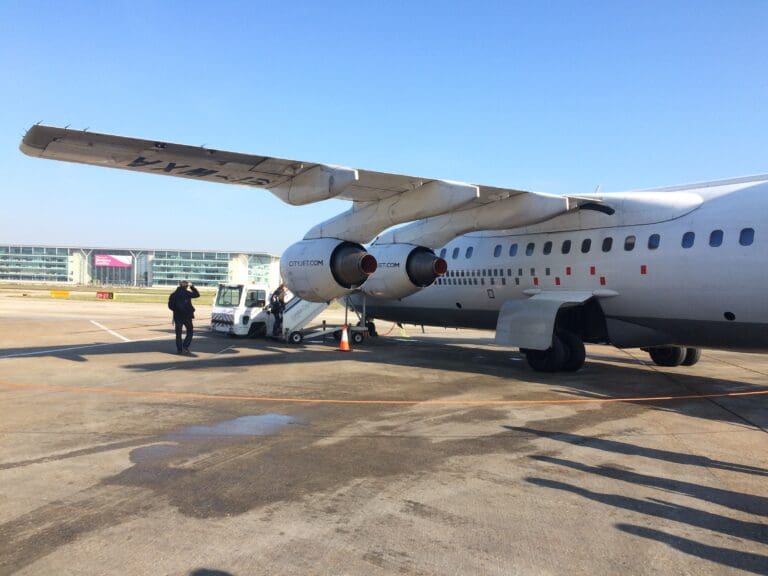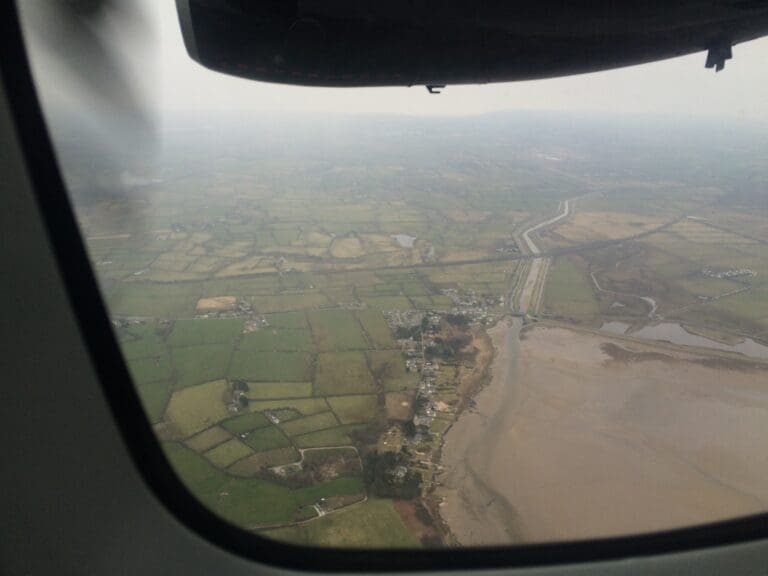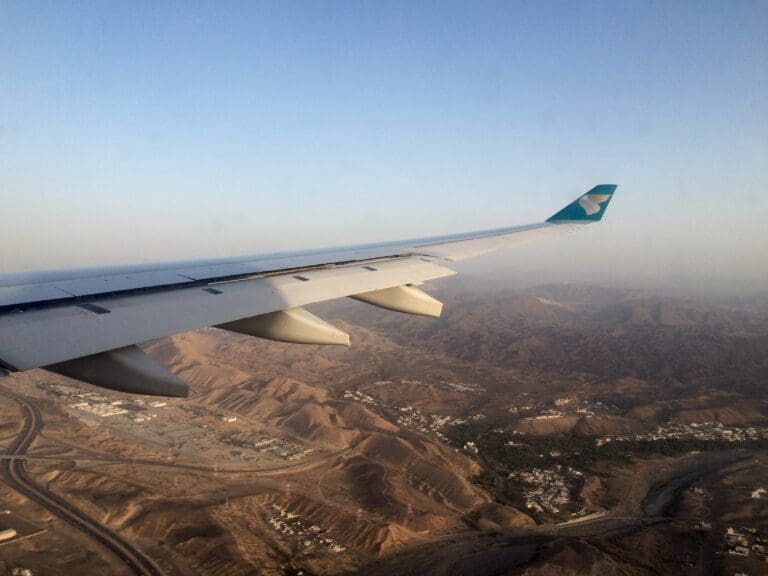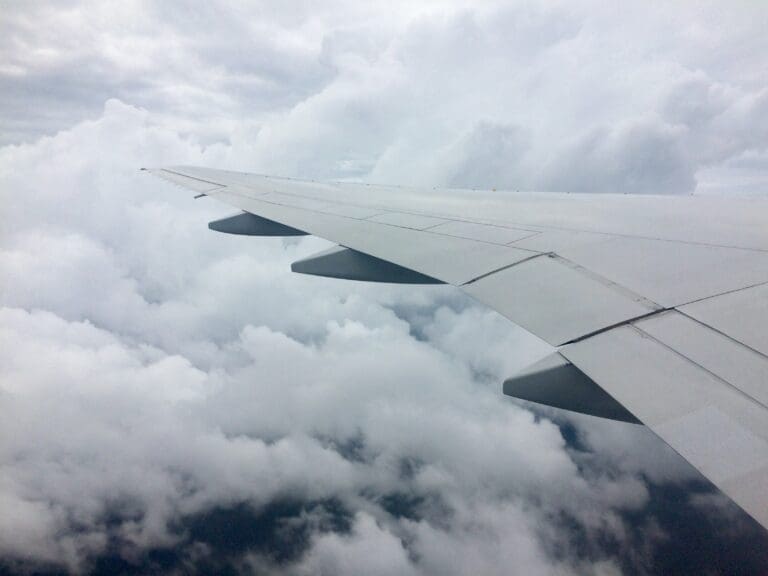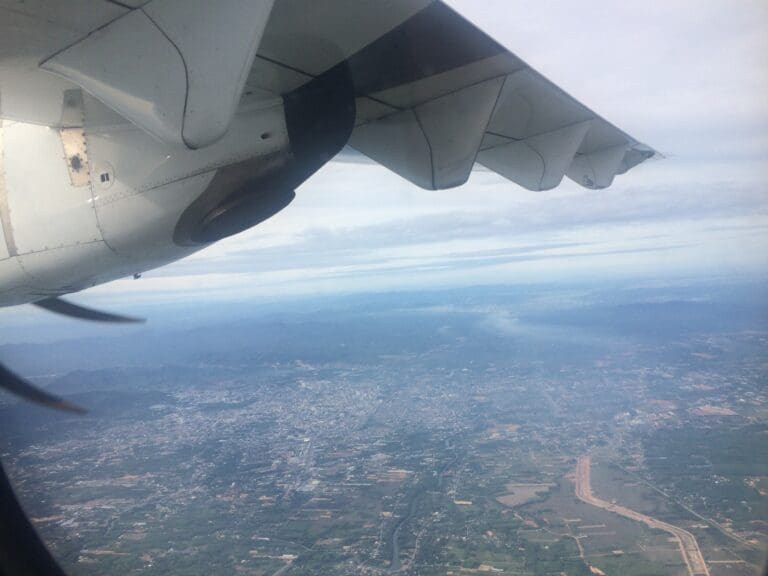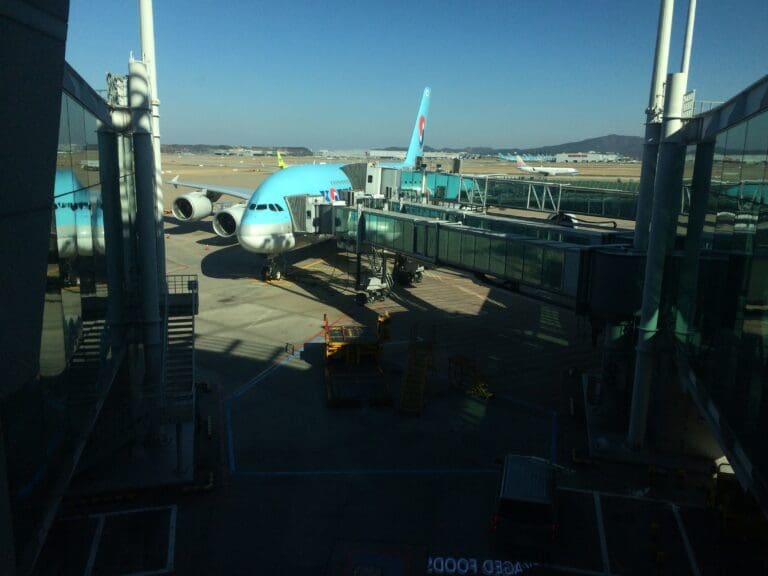Remembering Flybe 1.0: Paris CDG to Birmingham on a Embraer 175
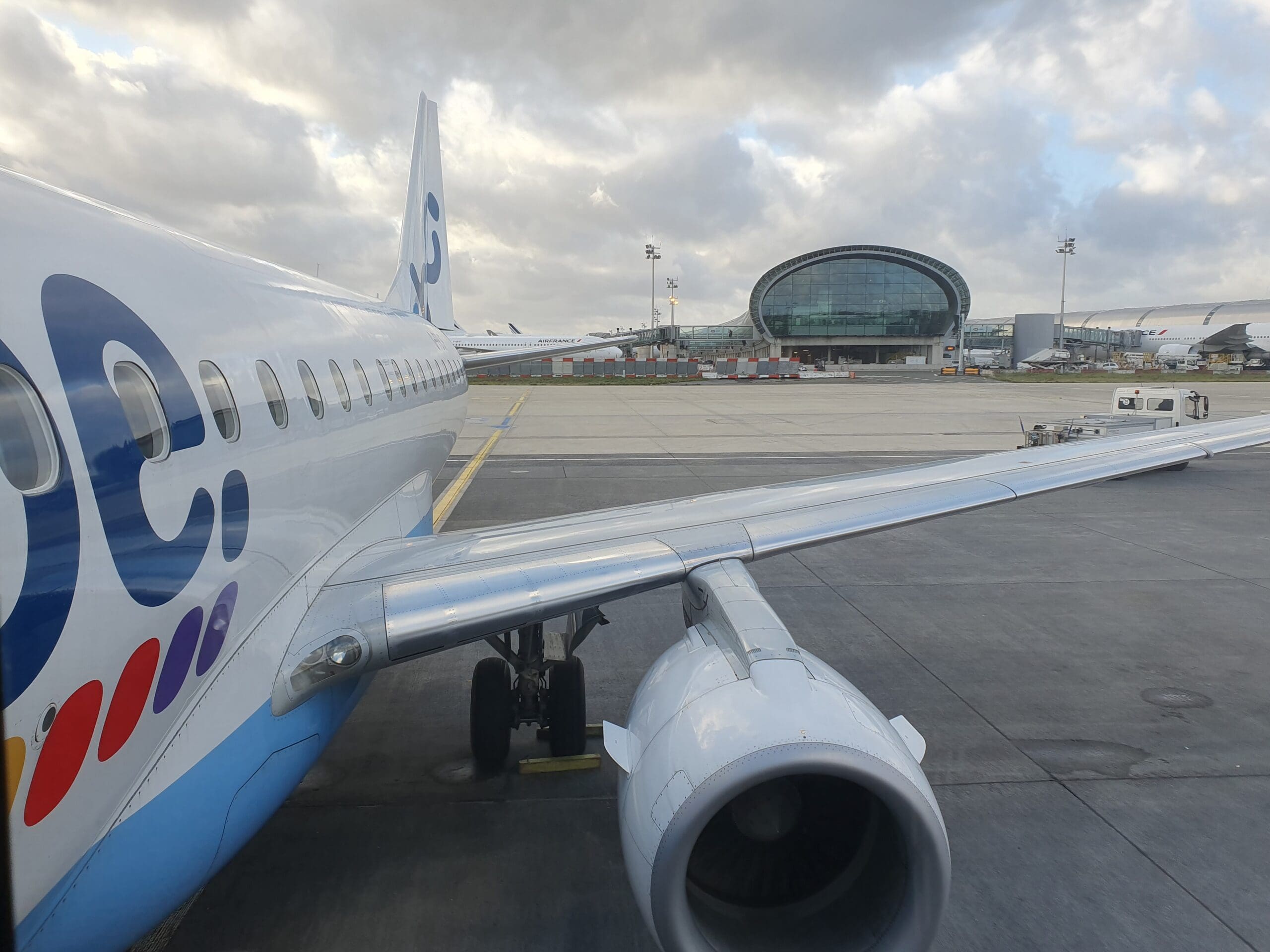
You can read the first instalment in my ‘Remembering Flybe’ series here, which details my Dash 8 Q400 ride from Birmingham to Bordeaux.
Background
Living in Paris but needing to get back to Sheffield to spend Christmas with my family, fearful of unusually high costs over the peak Christmas season, when September rolled around, I began to look for options for my festive week back home. Short on time and with my company’s office located near Gare du Nord, despite being an aviation enthusiast, my first port of call was Eurostar’s website. With this option consisting of a two-hour ride to London, and then another two-hour train ride back to Sheffield, also departing from St Pancras, this was the quickest, most convenient and most logical way of getting back. However, my plans were halted when I discovered that return tickets for this journey would cost around £250! Seeing this as incredibly steep, I headed to Skyscanner in search of cheap flights.
Connected to my hometown by regular direct rail services that take just over an hour to head across the Peak District, Manchester Airport is usually my airport of choice when travelling to and from Sheffield. However with return flight prices with Air France, Flybe and Easyjet all nearing £200, plus given the inconvenient departure times for the outbound leg, I soon passed on this option. I then turned to Birmingham Airport – a 1H40 rail journey away from Sheffield involving a (usually) painless change of trains at Birmingham New Street Station. Not only is the airport convenient, but I have also noticed that flights to and from the airport are often cheaper than from other regional counterparts. Once again this proved true, with return flights from Paris to Birmingham serving to be far cheaper than those to the UK’s other regional airports. The cheapest of these was priced at a mere €90 on Air France’s website! Unfortunately, with this involving a morning departure from Paris CDG (impossible due to the fact I was expected to be at work that morning), I was left with no other option but to opt for a mid-afternoon flight, departing at 1520 and returning late in the afternoon on the first day of 2020. The total for these flights came to €137.05 without luggage or seat reservations.
However, given my previous experience with Air France’s website, it is perhaps fair to say that any rational passenger would have avoided booking directly with the airline like the plague. Having opted to book via the carrier’s site upon moving to Paris the preceding summer – I had attempted to purchase tickets from Birmingham to Paris via Bordeaux (an indirect routing but the only cheap option several days before departure). Unfortunately, after paying for this, I received neither a booking reference number nor a ticket. To receive these, I had to spend several frustrating hours on the phone with multiple (rightly) puzzled call centres. Fortunately, I did eventually receive the ticket I had paid for several days later. In terms of the flights themselves, the mixed-bag experience that flying with Flybe can prove itself to be was fantastic, however, I had been disappointed with my Hop! hop from Bordeaux to Orly on a relatively new but battered and dirty CRJ-1000. However, realising my experience with Air France’s site was most likely a one-off, and, being able to differentiate between Hop! and mainline Air France, I was willing to book with the airline again. Especially seeing as my three previous experiences with the airline (all short flights with on their A320 Family fleet) had been positive.
Skipping the options to reserve a seat and add additional hold luggage (both only possible for the inbound Air France-operated flight) as well as guiltily not opting to donate any money to the environment, my fare came to a reasonable €137.50. I would depart Paris CDG on Christmas Eve at 1520 onboard a Flybe Embraer 175, arriving in Birmingham at 1545 UK time. A little over a week later, I would embark on my first flight of 2020 onboard a somewhat rare Airbus A318 belonging to Air France, departing Birmingham at 1445 and arriving back in the French capital at 1705.
My last flight on one of Flybe’s Embraer jets had been on a chilly evening back in November 2016 – which, by coincidence also involved a departure from Paris CDG, although that time I had been heading to Manchester. That evening the aircraft’s cramped, untidy and battered cabin came as somewhat of a shock after spending twelve hours enjoying the spacious luxury of one of Korean Air’s Airbus A380s. Given my great experience with Flybe on my Dash 8 Q400 operated service to Bordeaux, I hoped for a better experience this time around.
Check-In
Online check-in for the majority of Air France’s flights opens 30 hours before departure, whilst Flybe allows its passengers to check-in 36 hours before departure. As per usual, favouring an online check-in, I planned to do this via Air France’s app the day before my flight. At 1100 on the day before my departure, I was sent a notification reminding me to do this via the app however I soon received an error notification informing me that this was not possible, receiving a similar message upon attempting to check in via both the Air France’s British and French sites. Meanwhile, Flybe’s website was equally useless in this respect as after entering my booking reference and surname I was redirected to Air France’s site where I was once again presented with the same error message.
Interestingly, according to Flybe’s website, all Flybe passengers departing Paris CDG and looking to check-in online had to do so via Air France’s website, regardless of which airline they purchased their ticket with. Deciding to try to check-in online once before my flight, I was delighted to find that this was possible at 1540 – indicating that online check-in is not possible until 24 hours before departure for Flybe’s services from Paris (despite no mention of this on the website of either Flybe or Air France). Having already entered all my details, checking in via Air France’s app was an easy and quick process. Whilst doing this I noticed that I had automatically been assigned Seat 21A near the rear of the aircraft – this was unchangeable however I was grateful for the fact that this was a window seat.
Journey to the Airport
Almost as soon as I woke up on Christmas Eve Eve Monday, I headed to RATP’s website to check the latest status of their network – as expected, once again I would have to walk an hour and a half across the city to get to work, albeit this time lugging a small suitcase alongside my regular work bag. More importantly, I had a look to check the status of the RER B line which runs through Paris to Paris CDG. As had been the case on most of the other strike days, only 1 in 3 trains would be running, with these only in operation between 0630 and 0930 in the morning and 1630 and 1830 in the afternoon/evening. As one would expect given the limited trains on this important commuter line, pictures and videos of long queues, overcrowding and crushes had come to flood social media during the strike. It was thus fair to say that I was not looking forward to my trip to the airport.
As soon as my busy three-quarter work day came to a close, I bid a festive farewell to the few staff members hardy enough to brave Christmas in the office, zipped away my laptop and slung the flying bag I use to transport this around my shoulder and dragged my small suitcase out of the office. Leaving just after 1600, I commenced a brisk walk down from Oberkampf to Republique before heading up the slight hill that leads to Gare du Nord, arriving at the station at around 1630. Whilst the streets were chaotic and crowded that afternoon, Gare du Nord seemed to be its usual busy self, neither suspiciously quiet nor worryingly crowded. However, simply judging whether the RER would be rideable simply by the number of passengers mingling in the main ground floor station area would be a little foolish and so I tried not to get my hopes up too soon. Heading down the escalators towards the RER platforms, I was pleased to see that this was only ‘rush hour busy’ as opposed to the ‘armageddon busy’ I had expected given the scenes of chaos featured on social media.
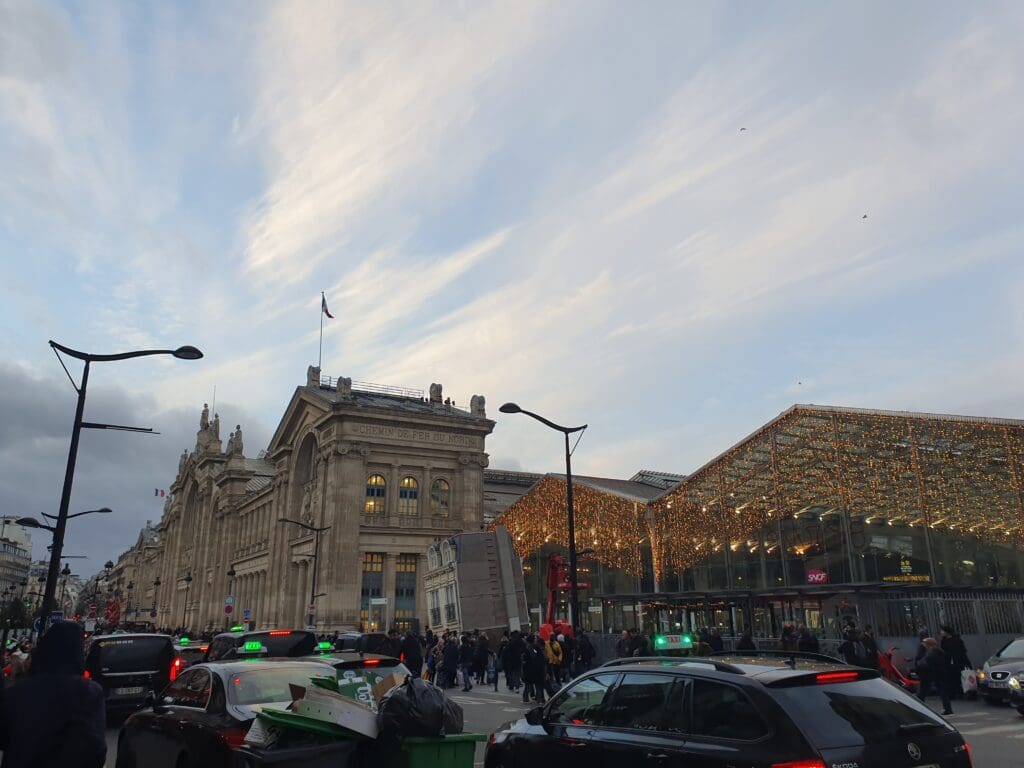
Seeing a departure bound for Paris CDG-2 at 1647, I made a brisk walk along the blue line towards the RER platforms, arriving approximately three minutes before departure. At the platform an army of ticket inspectors and other staff could be seen ushering people onto the waiting train, I happily stepped onto what was a busy, yet far from overcrowded train with a few seats left. It soon became apparent that I had arrived at the right time as the train soon became standing-room only. As scheduled at 1647 the doors shut and we commenced the 11-stop journey through Paris’ northern suburbs towards the airport. Whilst the RER B may be convenient, I am sure most will agree that it will not win any awards for comfort or cleanliness, both of which leave a lot to be desired, with the train taken in a rather dire state. However, given the fact this delivered me to Paris CDG in the midst of the strikes, I cannot really complain about the state of my ride. Around forty minutes after departing Gare du Nord, the train arrived at its terminus and I disembarked, still in slight disbelief at how painless the journey had been.
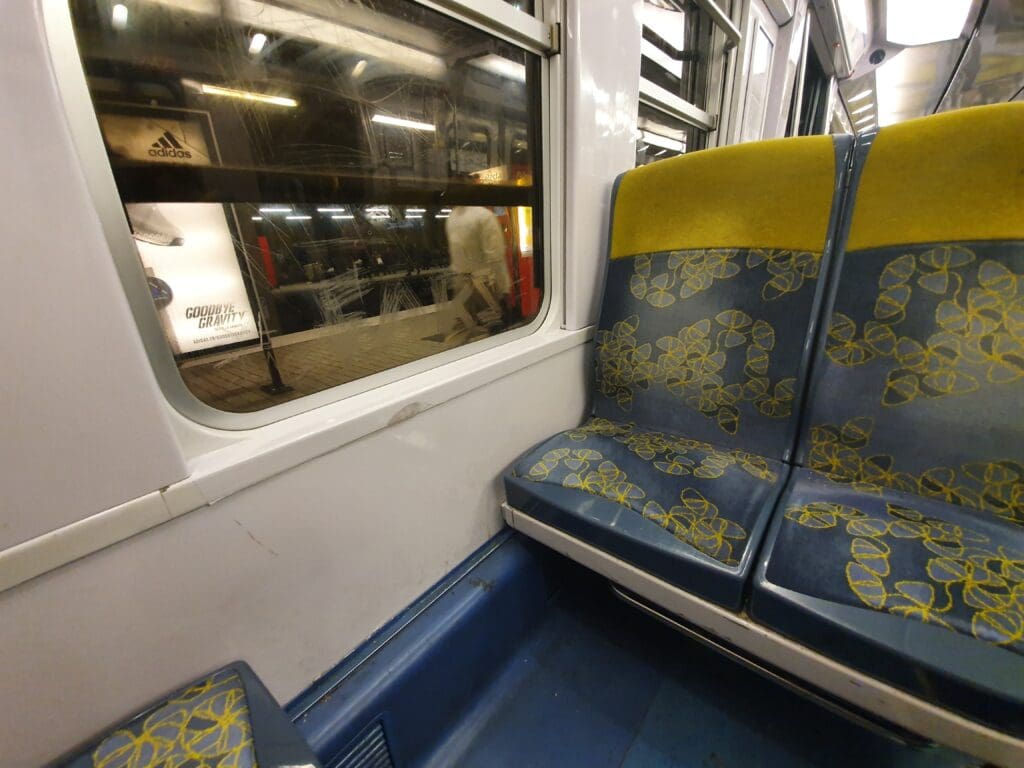
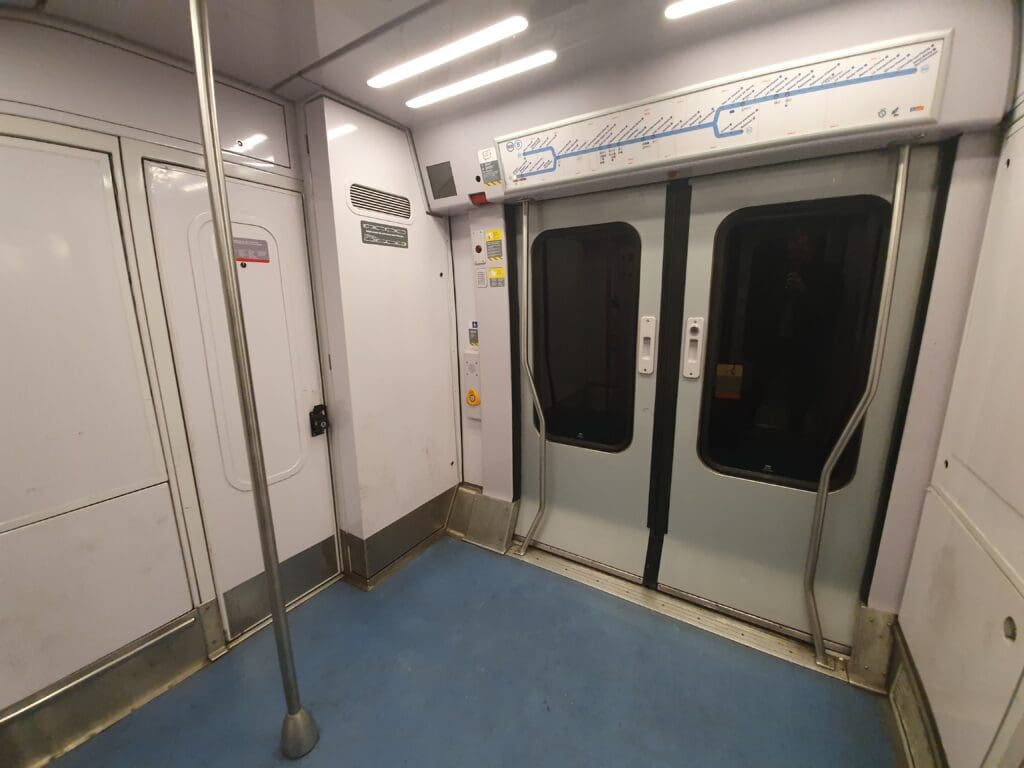
Once in the airport, I headed up through the SNCF station, and, following the advice of the staff I made my way to the hotel shuttle bus stop on the fifth floor. I did however make a brief stop at an Air France check-in machine to print off my boarding pass for my flight to Birmingham the following day. After a 20 minute wait, the minivan that would deliver me to the hotel showed up and whisked me and one other lodger to Roissypole and then onwards to the small village of Le Mesnil-Amelot, located near the thresholds of Runway 27L/R. Once at the hotel, I made a quick check-in and paid the €5 fee for the shuttle ticket back to the airport. Whilst I won’t give a full description of my stay, whilst not the height of hotel excellence, this was pleasant enough and most certainly reasonable value for money considering I paid just €40 during the peak Christmas rush.
The Journey
Synonymous with chaos, it does not take long for visions of snaking queues and disgruntled, grumbling passengers at airports and train stations as well as endless traffic jams on the roads to pop into mind when thinking of travel over the festive period. Yet, seeing as my Christmas Eve flight was set to depart in the afternoon with Christmas Day on final approach, I tentatively hoped for a calm and pleasant experience in between the pre and post-Christmas chaos. Indeed, any rational traveller with an understanding boss would likely already find themselves eating mince pies with their loved ones on Christmas Eve afternoon and not trapped in a major airport. Prepared for lines of all sorts of lengths, and, given my unusual passion for waiting in airports, I departed from my hotel onboard their 1130 shuttle bus to Terminal 2, a good four hours before my flight’s scheduled departure time. Although admittedly, given the hotel’s 1200 check-out time, I had little choice but to leave and head to the airport.
No more than ten minutes after leaving the hotel, the minibus pulled up to the terminal and I was handed my small suitcase by the angry driver before I made the five-minute walk to Terminal 2E’s large check-in hall. Designed by the late French architect Paul Andrea, the landside portion of the airport is modern and serves to be one of Europe’s more architecturally inspiring check-in halls that I have passed through. Despite my concerns, starting my journey on the right foot, the terminal did not seem to be incredibly busy, with a reasonable number of passengers, but no more than I would usually expect to see at the airport. Acting as the start, end and mid-journey stop for passengers heading to and from destinations outside of the Schengen area, sub-terminal 2E is, by nature, highly international. Inside, people can be seen heading off to all corners of the world. On the apron, Flybe’s comparatively minuscule Dash 8 Q400s and Embraers rub shoulders with widebody jets from Air France, Air Mauritius, China Eastern Airlines, China Southern Airlines, Delta, Korean Air and Vietnam Airlines. Aside from the hometown airline and Flybe, at that time TAROM was the only airline to serve the sub-terminal with narrowbody jets. Seeing as I lacked checked-in luggage, having checked in online and holding three different versions of my boarding pass, after a quick look around the landside area of the terminal, I headed onwards to immigration and security.
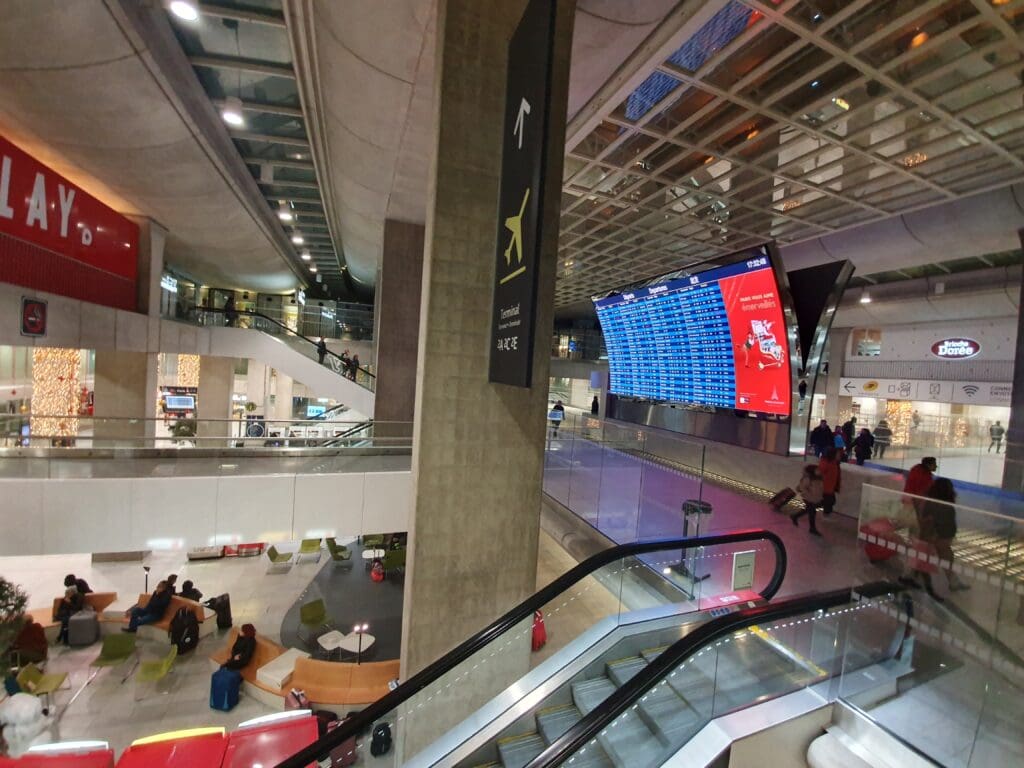
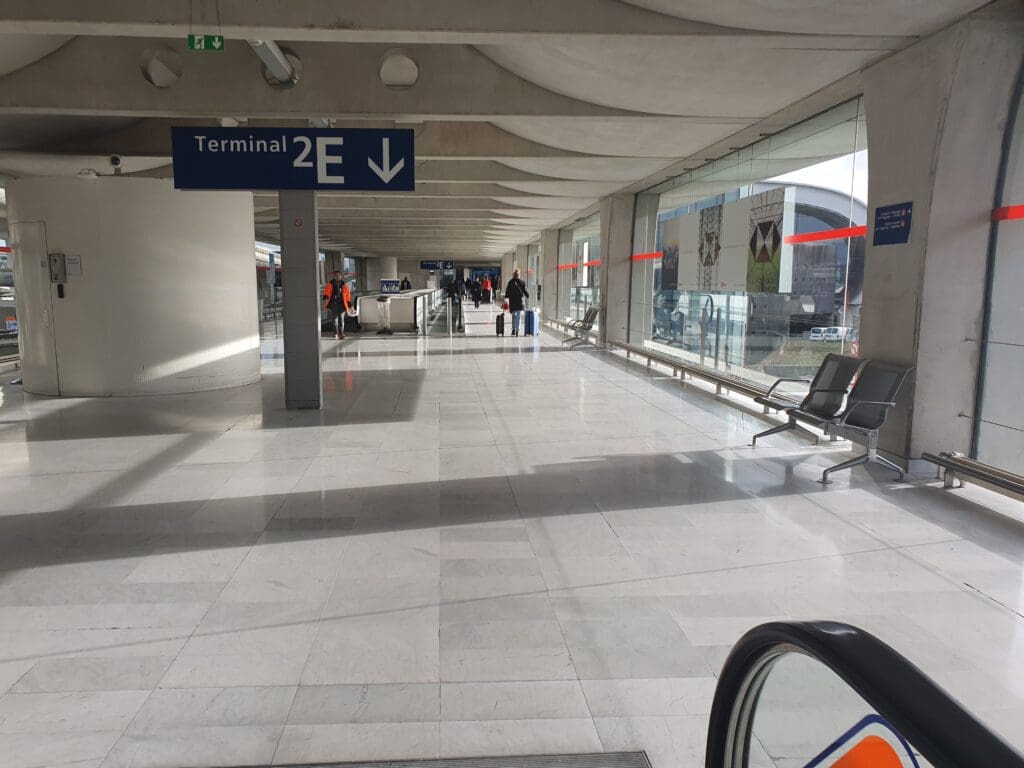
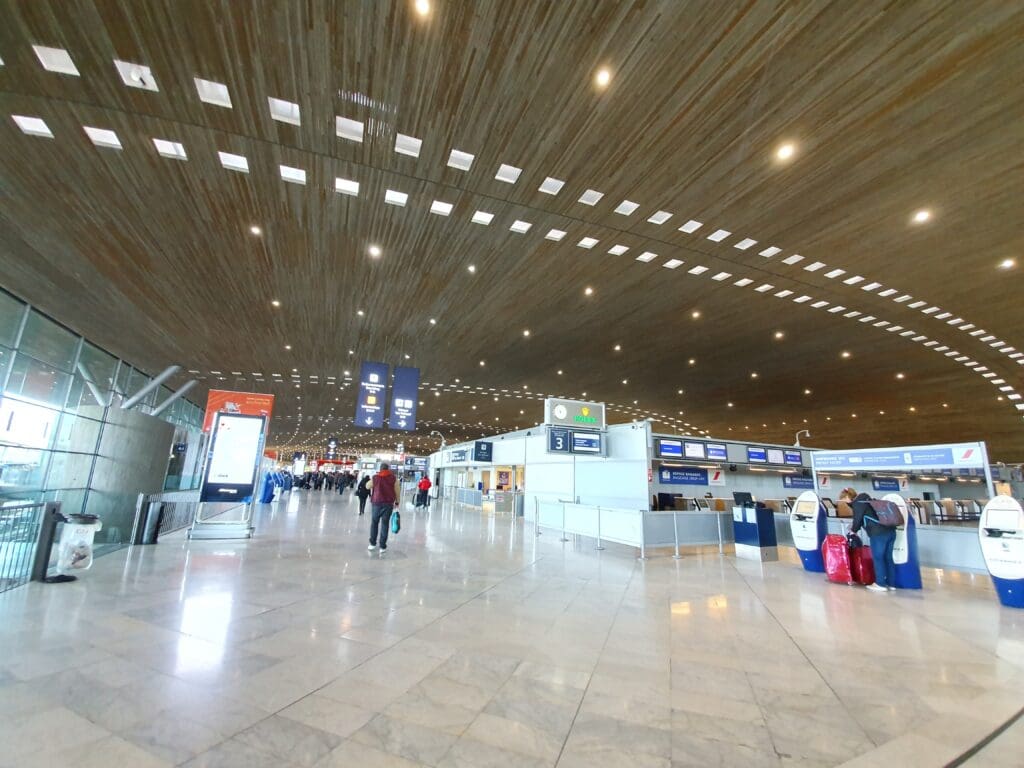
Fortunately, I was able to use one of the e-gates on offer for those departing from the terminal. After having two quick checks of my boarding pass and passport, without any queuing whatsoever I headed to the automated immigration gate, this took no more than half a minute to allow me to exit France. Once this initial check is complete, passengers are then siphoned off, with those heading to the terminal’s K gates able to walk there, whilst those heading to the L and M satellite terminals are required to catch the terminal’s automated shuttle train. Having inadvertently timed things just right, I arrived at the station just as the next departure pulled up and I was soon transported along with only a small handful of other passengers to the L gate area. During this journey, good views were offered of several of Air France Airbuses waiting at the K area of the terminal. After disembarking the train, I headed up the escalators to the security area, and, after a small wait, whilst my boarding pass was checked once again, I joined one of the small queues there. Thankfully, given the fact that around two thirds of these checkpoints were open and the relatively small number of passengers there at the time, passing through this took no more than three minutes. All in all, my landside to airside journey that lunchtime had been a positive experience – with minimal queuing and friendly staff. Interestingly, this was a far cry from the semi-disastrous experience I had when passing through the terminal in late November 2016 on my way from Incheon to Manchester.
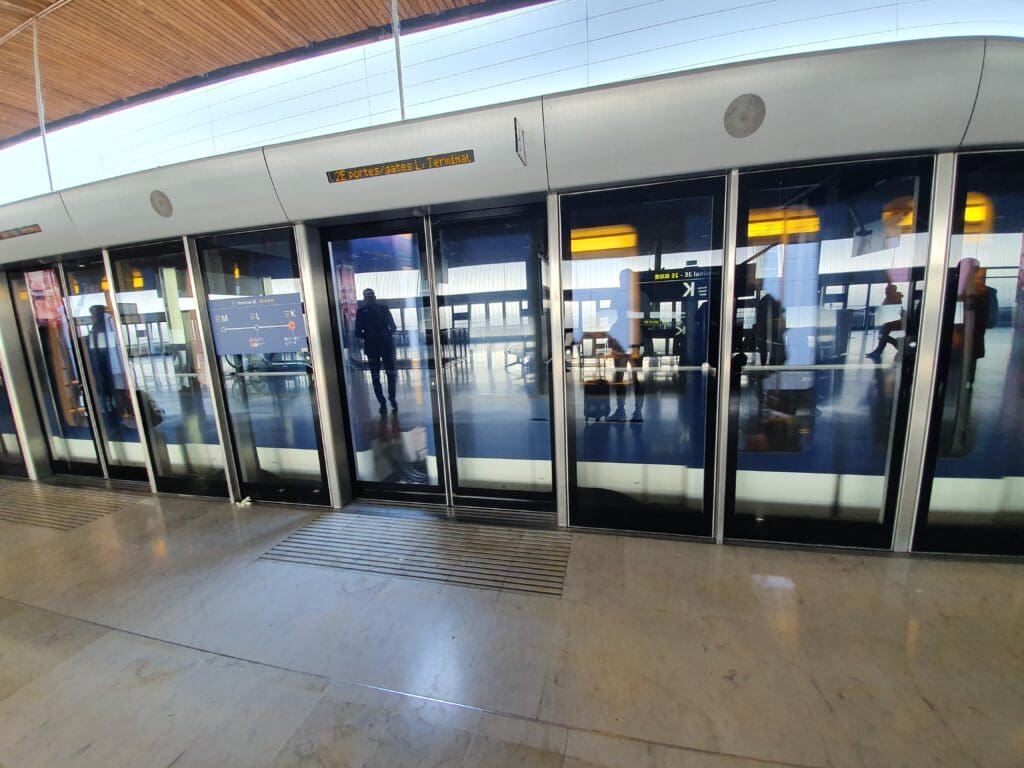
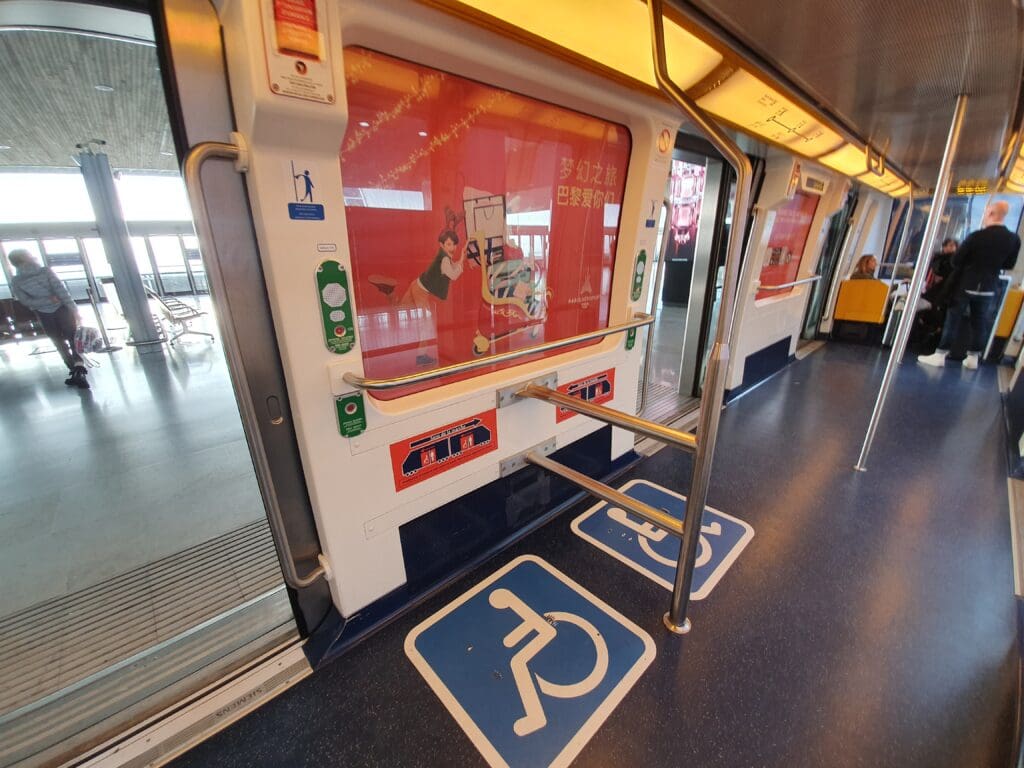
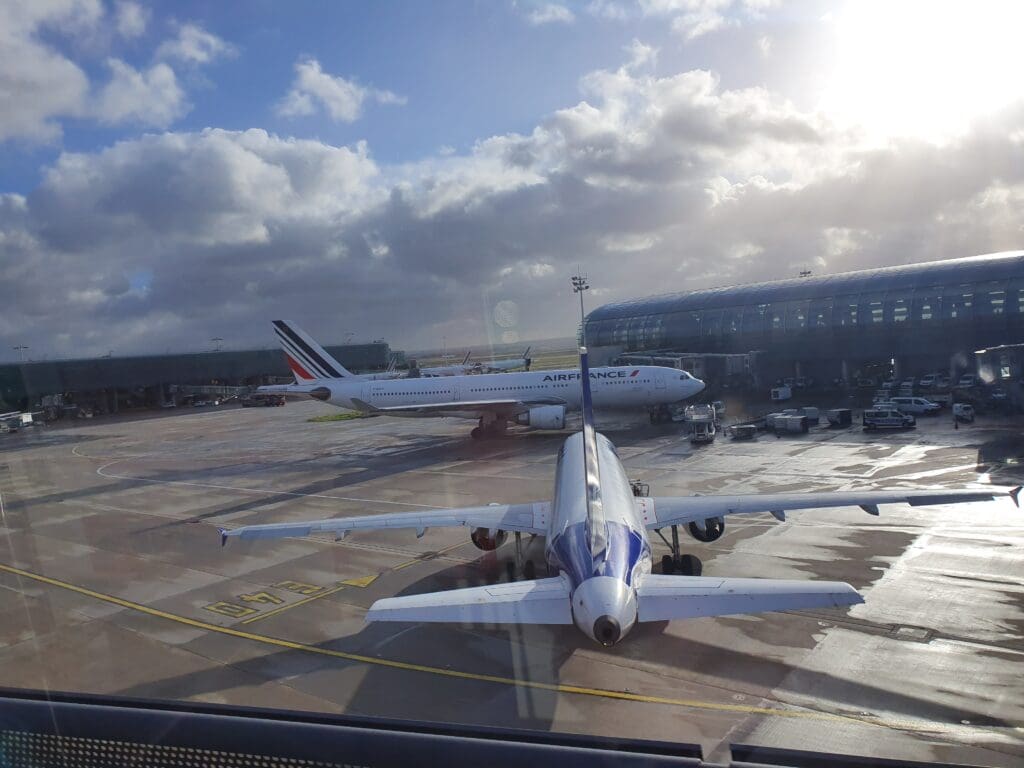
Airside, other than being somewhat dirty with significant amounts of rubbish visible across the terminal, the satellite terminal was not too bad. From an enthusiast’s perspective, large windows offered good views of parts of the ramp as well as of the aircraft approaching and holding for departure on Runways 26L/R. These also provided plenty of natural light which I am sure is appreciated by many passengers. Meanwhile, plenty of shops are on offer as well as several cafés, for those in need of shopping and/or refreshment, whilst several vending machines provided some slightly cheaper (albeit still above average priced) options.
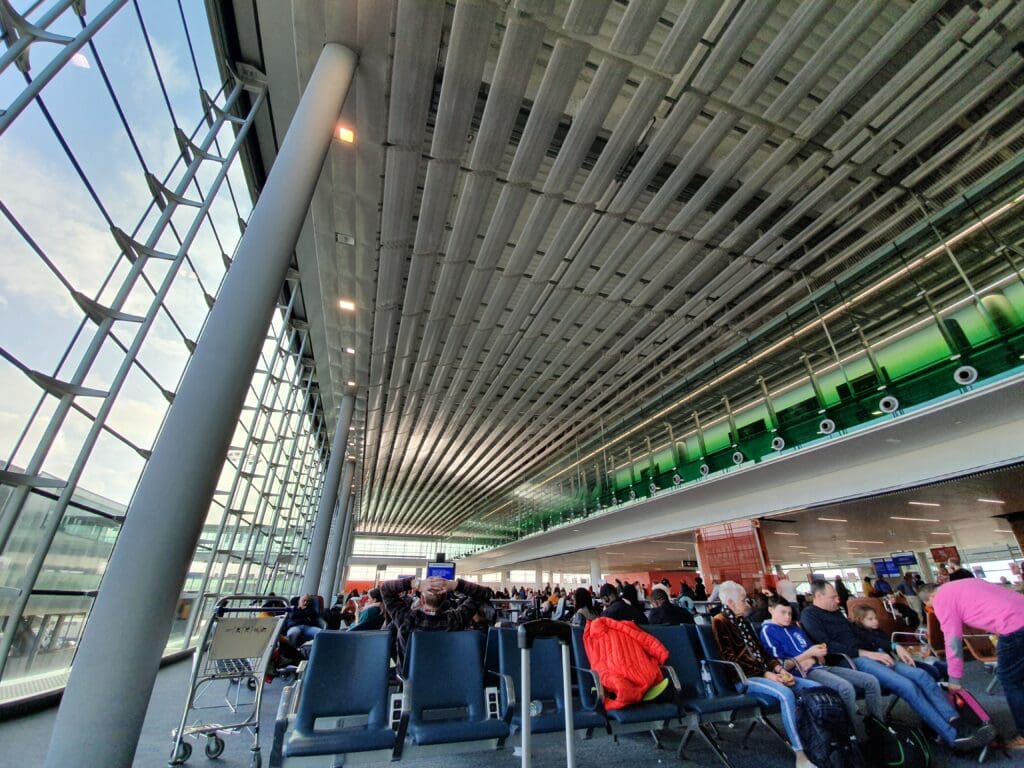
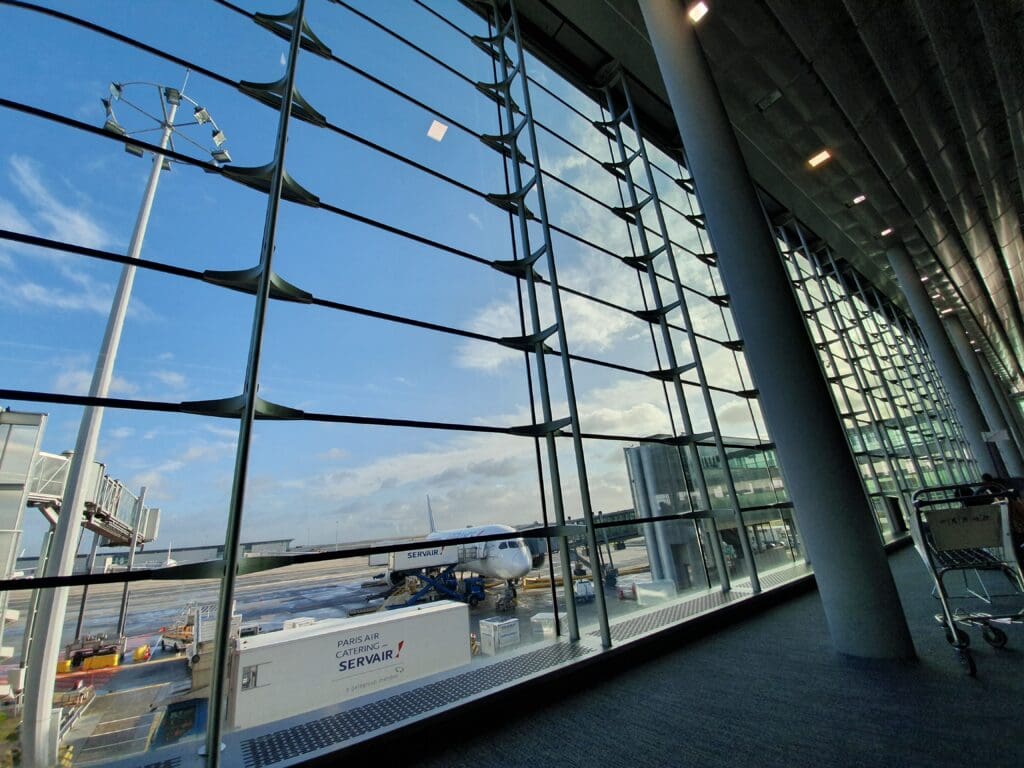
Needing to get some work done, after a brief stroll around, I took one of the many empty seats, plugged in my laptop and phone (each seat features a couple of USB-A ports and a plug socket), connected to the wifi and proceeded to work – stopping occasionally to admire the aircraft outside. That afternoon majority of aircraft consisted of Air France Boeing 777s and Boeing 787-9 Dreamliners heading to a diverse selection of destinations across Africa, Central, North and South America, the Middle East and East Asia. In my opinion, this made Birmingham appear to be the least interesting destination on the departure boards! One interesting aircraft seen during my time at the airport was Air France, Airbus A330-200, F-GZCF which was still sporting Air France’s old livery, almost eleven years after the airline’s current livery was unveiled!
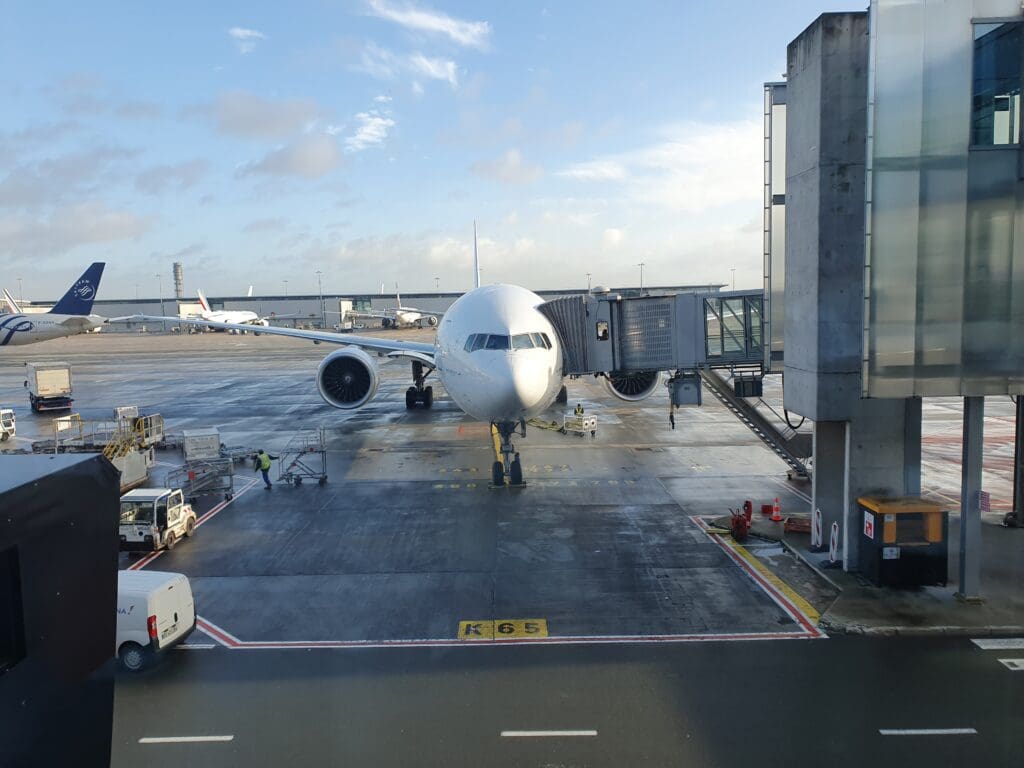

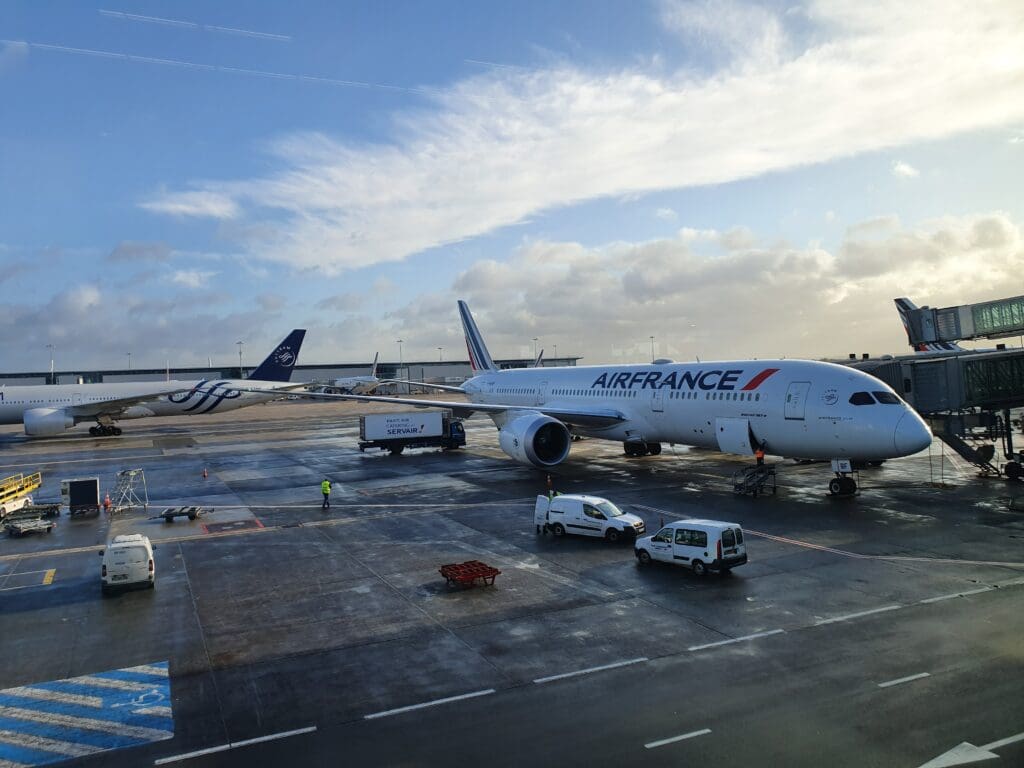
As time passed, the number of passengers milling about in the terminal seemed to remain constant which was rather unsurprising given the regular stream of departures. Being an avid user of FlightTadar24, I tracked the inbound aircraft from the moment it departed Birmingham, taking off 20 minutes behind schedule at 1235 local time. As expected, the aircraft operating the flight would be an Embraer 175, G-FBJF to be precise. Still wearing Flybe’s old livery, this 88-seat aircraft first took to the skies of Brazil in early 2012 wearing the test registration, PT-TBM. In May that year, the aircraft was flown from Embraer’s facility at São José dos Campos to Birmingham with stops in Recife and Las Palmas. In the week before my flight, this Embraer 175 had completed a total of 39 sectors, connecting Birmingham with Amsterdam, Dusseldorf, Glasgow, Knock, Newquay, Paris CDG and Stuttgart, covering at least 10,100 miles in the process. To put this into perspective, this is equivalent to flying from Birmingham to the Australian city of Adelaide. Following Flybe’s demise, this aircraft would end up in long term storage before commencing a new life in its homeland with Brazil’s Federal Police in 2022!
Despite the late departure of the aircraft, I watched as this arrived ahead of schedule on Runway 26L at 1420 before taxiing to Gate L31. According to my boarding pass, boarding for the flight was scheduled to commence at 1435, a full 45 minutes before departure. Whilst this may seem reasonable for a widebody aircraft, I was somewhat sceptical that boarding an Embraer 175, even with a full load of passengers, would take that long. Plus given the inbound flight’s scheduled arrival time of 1430, unless the schedulers anticipated disembarkation and cleaning of the aircraft to take five minutes, I was a little doubtful that boarding would commence so early. Nevertheless, at this time, a reasonable number of Birmingham-bound passengers could already be seen waiting at the gate. Much to my surprise, at 1430 an announcement was made informing all that boarding would soon commence and to have their boarding cards and passports ready for inspection. As passengers waited, several staff members passed through the gate area, tagging cabin baggage and selecting the oversized bags which would need to be placed in the hold.
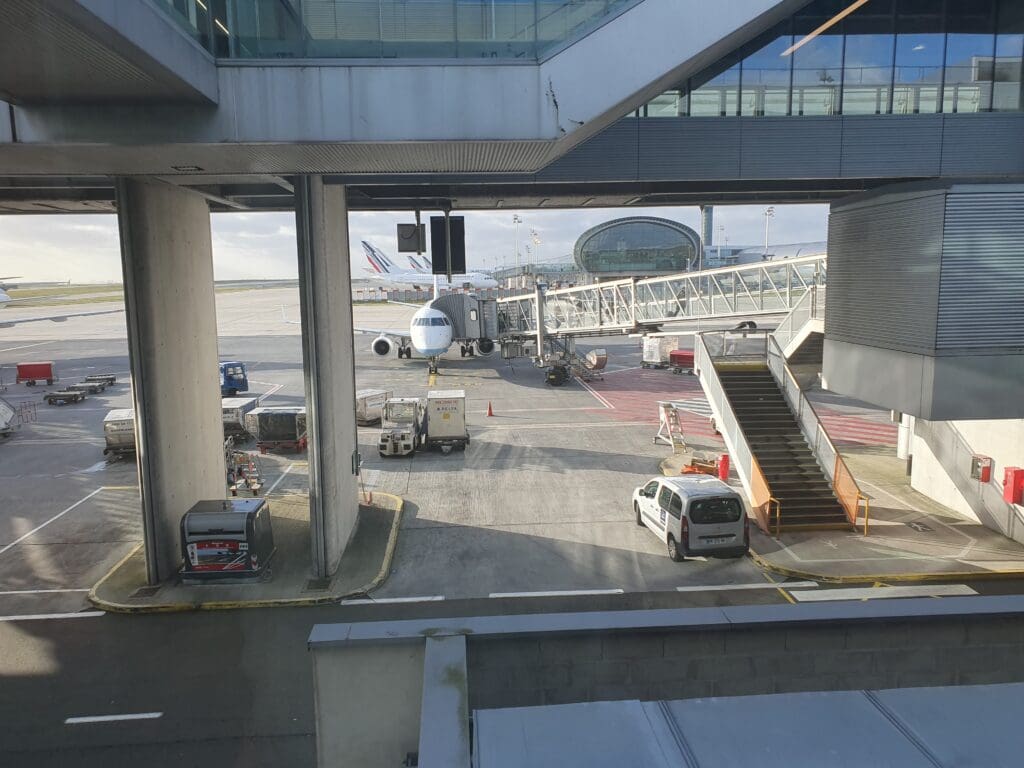
Almost immediately after the inbound passengers had disembarked the aircraft, at 1445 boarding commenced. This was done via automated boarding gates with a further identity check undertaken on the jetbridge whereby those holding non-EU passports were questioned about their trip and/or visa status by one of the airport staff members. Unsurprisingly given the early start to boarding, passengers were required to wait on the jetbridge whilst the cabin crew prepared the cabin for departure. This took some time and at 1458, boarding commenced for good.
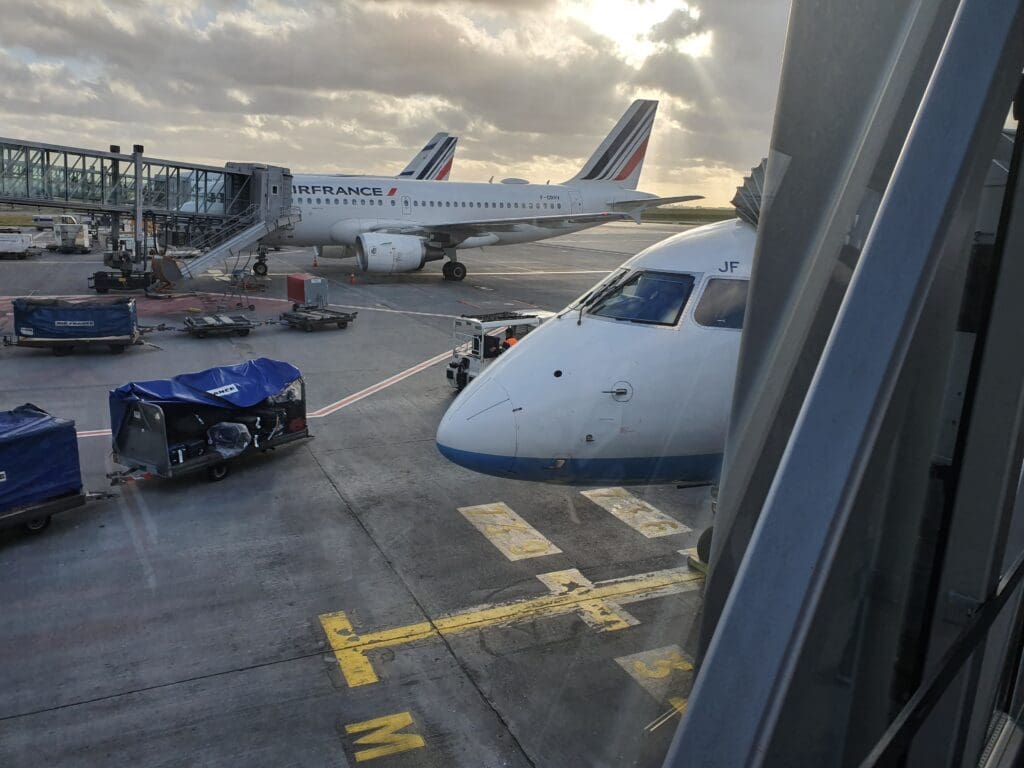
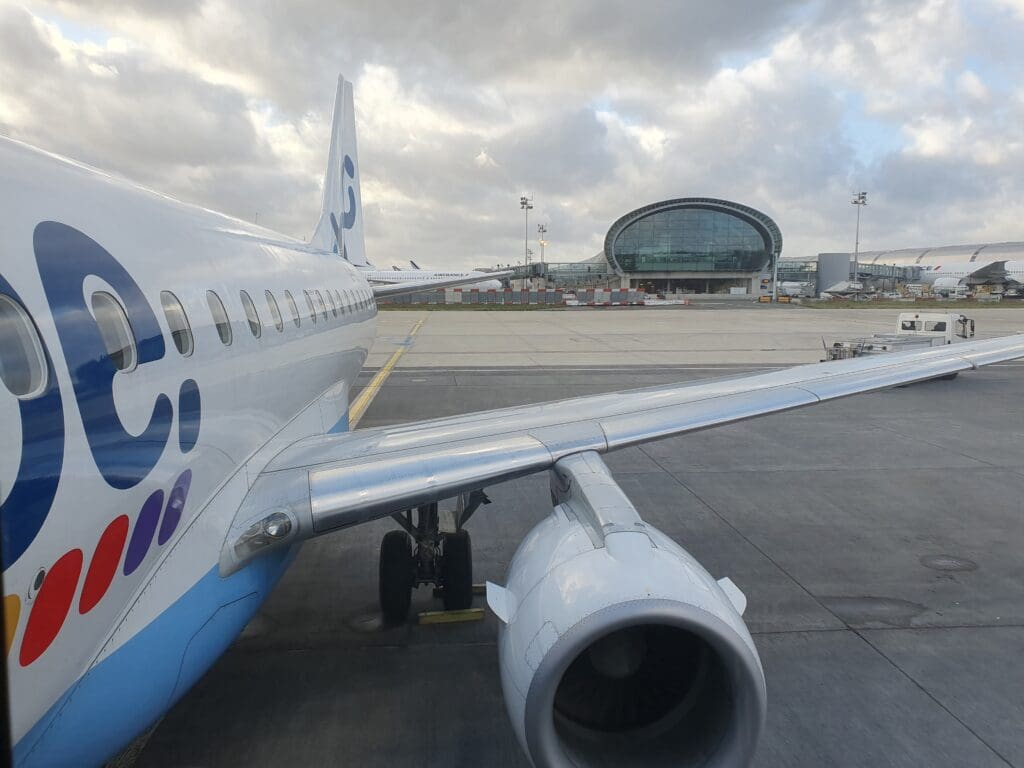
At this point, I made my way down towards the aircraft. After a very short wait at the aircraft’s L1 door, I stepped into the small forward galley where I received a very lively greeting in a heavy West Midlands accent, reaffirming that I had not boarded the wrong aircraft and was indeed bound for Birmingham! That day, the two flight attendants sported some festive additions to their standard Flybe uniform, whilst the Captain appropriately wore a Father Christmas hat. Seeing as I was one of the first to board, I soon reached the rear of this short and stubby Embraer and placed my small suitcase into overhead locker and my laptop bag near my seat whilst being welcomed by the other crew member – who, like the other flight attendant, spoke with a heavy Birmingham lilt. Seeing as I was yet to meet my seatmate, I decided to make a quick visit to the toilet seeing as I would likely be unable to do so during the flight. As per usual, I confirmed this was okay with one of the crew members. After receiving the reply ‘Of course you can lovey’, I entered the small toilet at the rear of the aircraft. As one would hope, this appeared to be clean and was stocked with all the basics, although it was a little worn and battered.
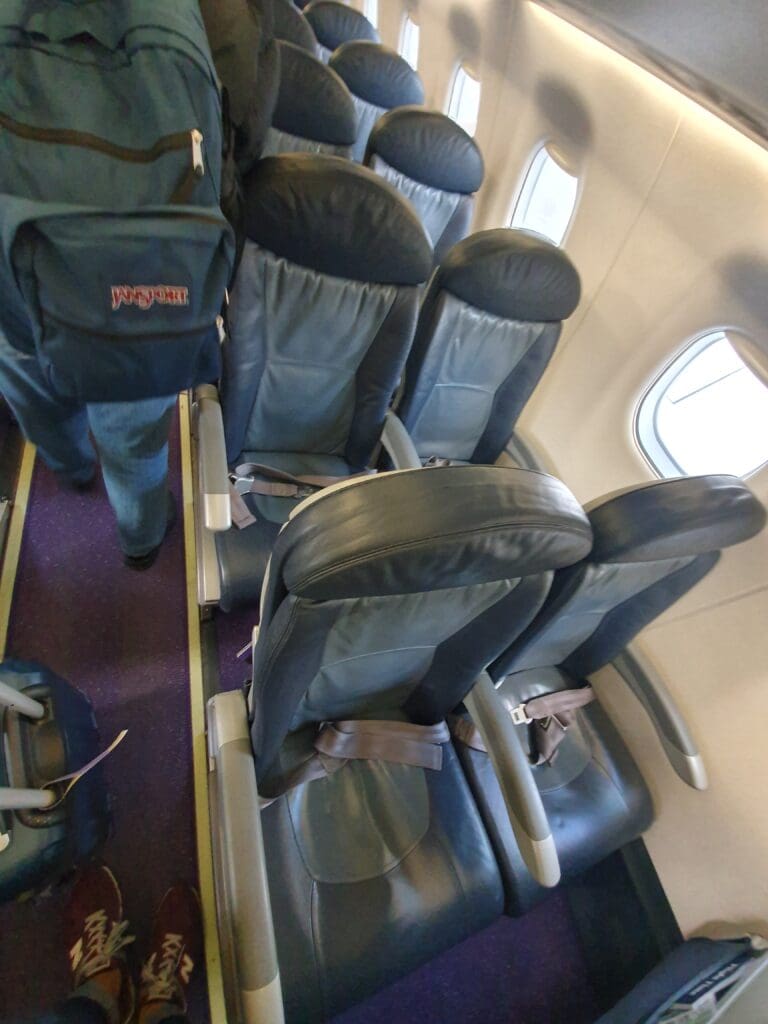
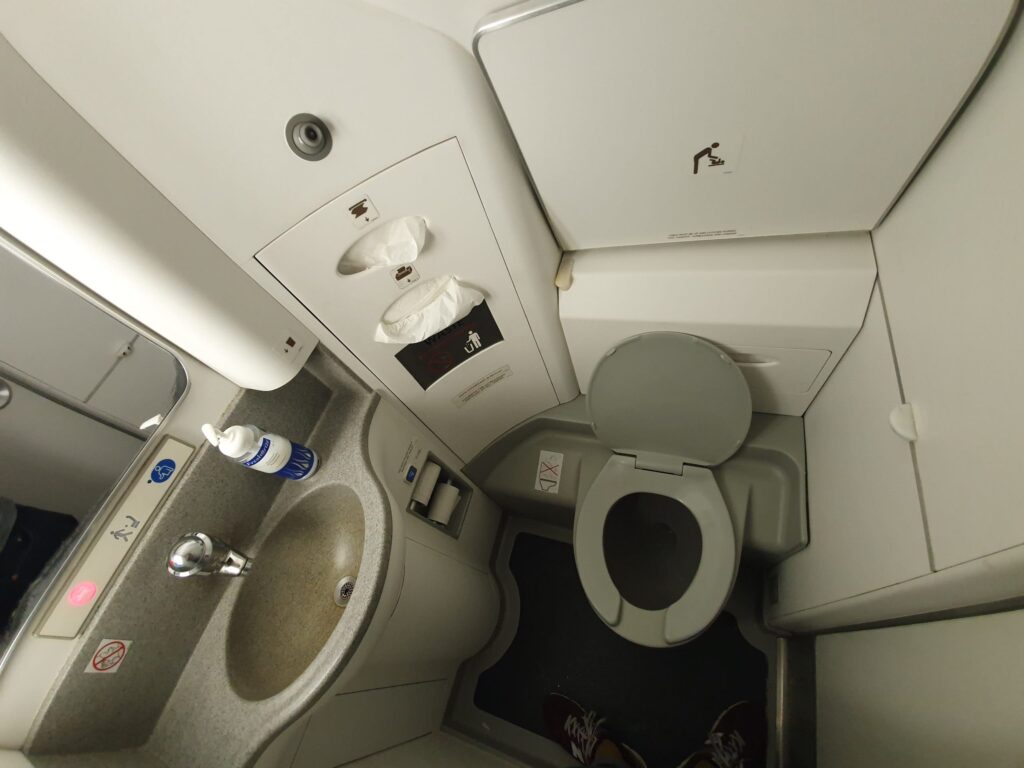
After a quick visit, I returned to my seat – like all onboard this all-economy jet, this was typically ‘Embraer’ in shape and style and covered in a grey/blue leather/faux-leather with no headrest cover. Despite being a little firm, comfort-wise this was reasonable enough and the amount of legroom provided was acceptable for the short flights the aircraft usually undertakes. Unfortunately, this is where my praises of the seat end. As with the other two E-Jet flights that I had taken with Flybe, the cabin appeared to be far from tip-top condition with plenty of marks, scratches and stains visible around my seat area. In addition, the cabin appeared to have been poorly cleaned during the turnaround with crisps all over the floor around my seat and on the seat itself. Turning to the seatback pockets, these contained everything that you would expect – a safety card, a copy of Flybe’s menu and inflight magazine as well as a sickbag.
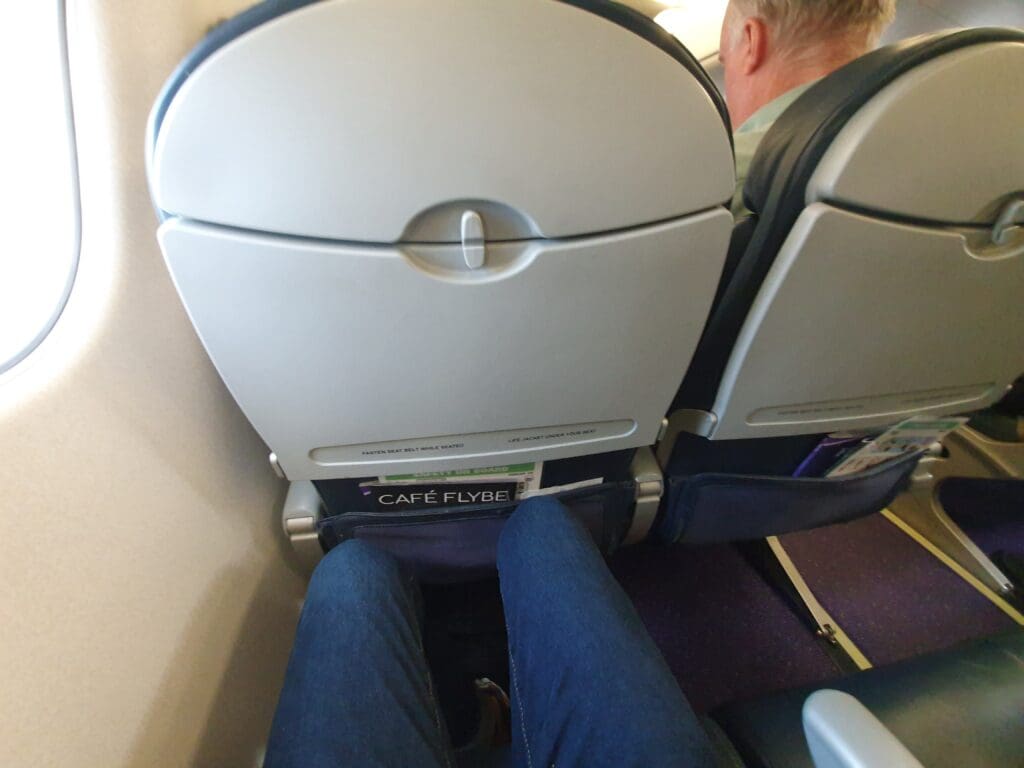
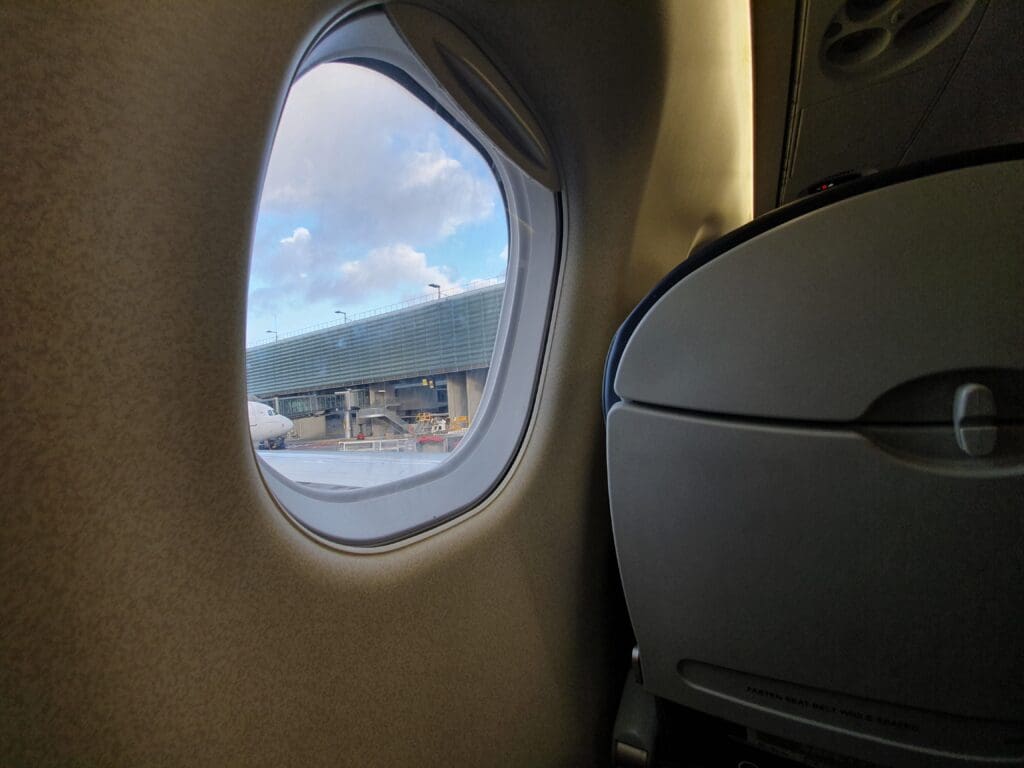
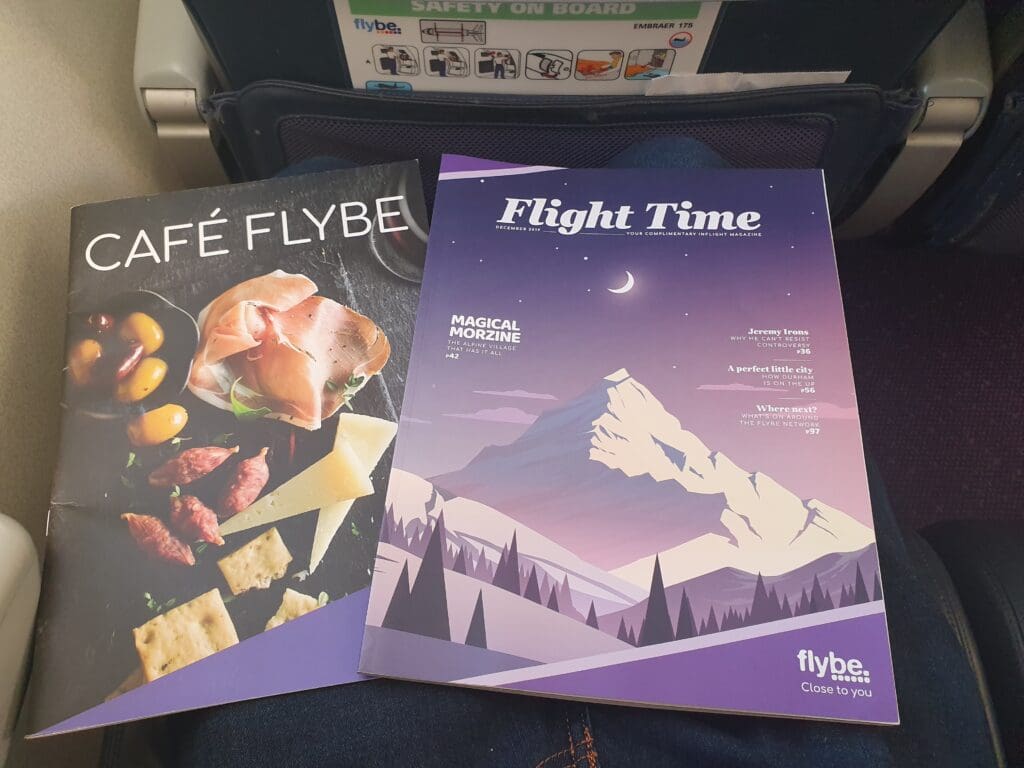
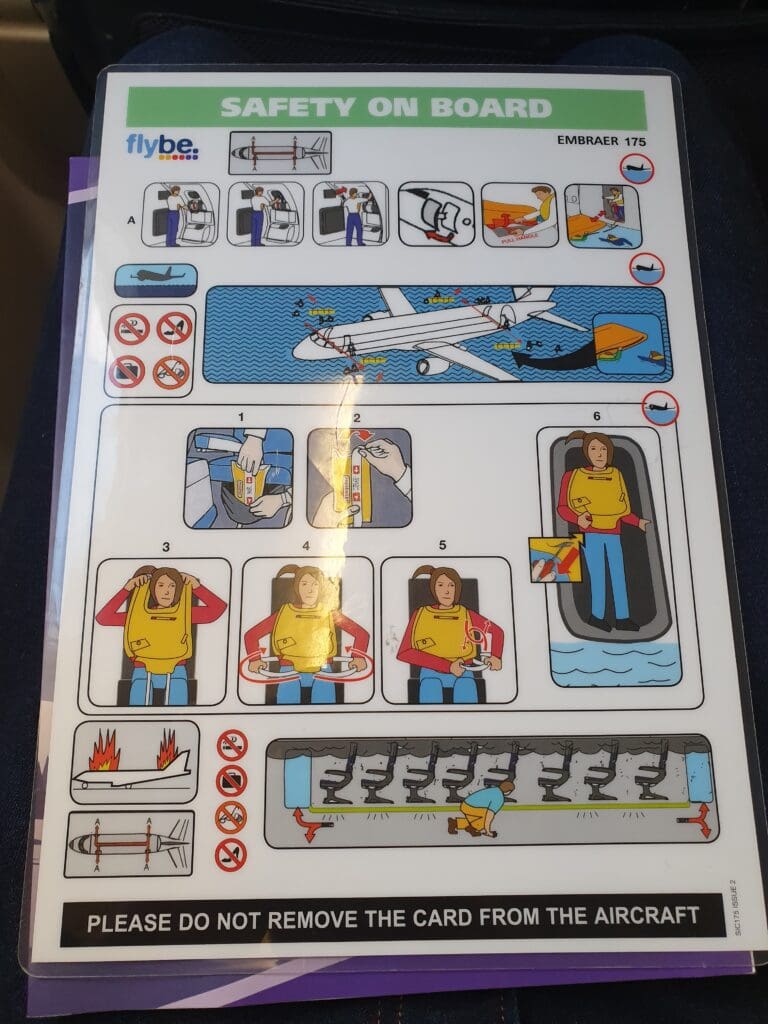
Despite the flight being around 90% full, boarding came to an end no more than ten minutes after this commenced. That afternoon, I would estimate at least two-thirds of the passengers to have arrived in Paris on flights from mostly far-flung destinations. Onboard were a sizeable group of friendly ice hockey fans returning from a pre-Christmas break in North America after getting their ice hockey fix alongside a significant number of solo passengers from Korea who (after overhearing several conversations) mostly appeared to be students in the UK. Meanwhile, many of those who like me had commenced their journey in Paris were families returning from Disneyland Paris. At around 1512, the Captain’s calm voice rang out through the small cabin and all were welcomed aboard. In addition, we were given a brief overview of the route and an introduction to the other three crew members onboard the aircraft. This was followed by a short welcome from one of the cabin crew members. Almost as soon as this announcement finished, at 1515 the aircraft was gently pushed back from Stand E21 and the aircraft’s two General Electric engines quietly powered up into life. Meanwhile, inside the cabin, the two cabin crew members performed a safety demonstration to a pre-recorded announcement – this played in English only.
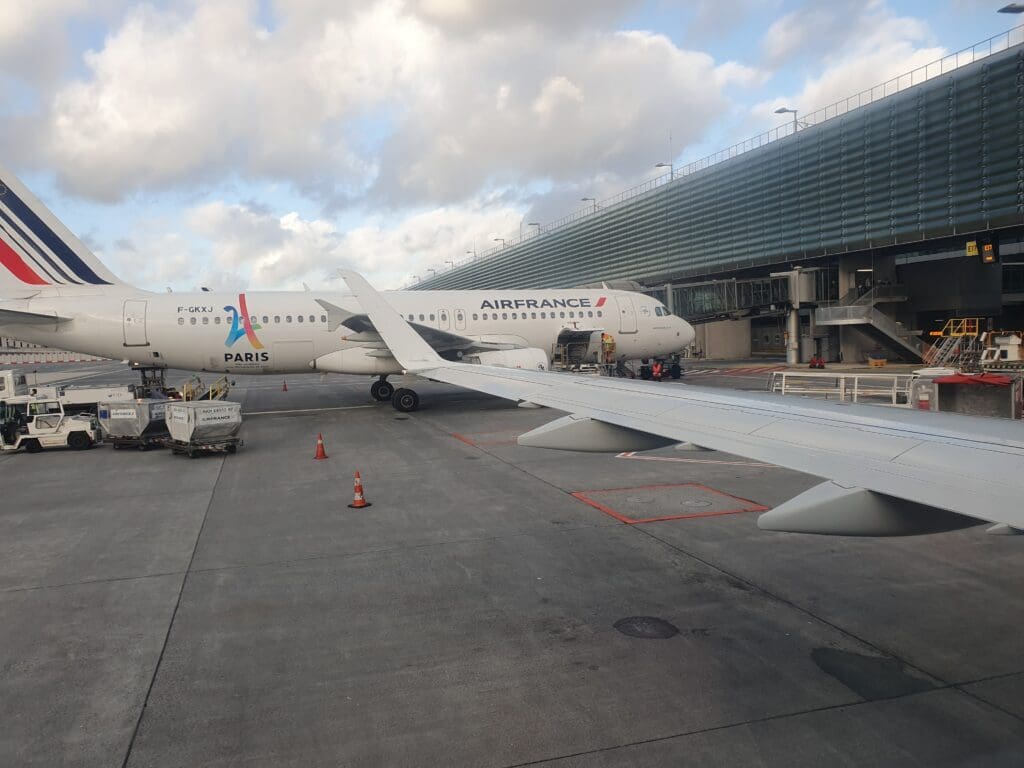
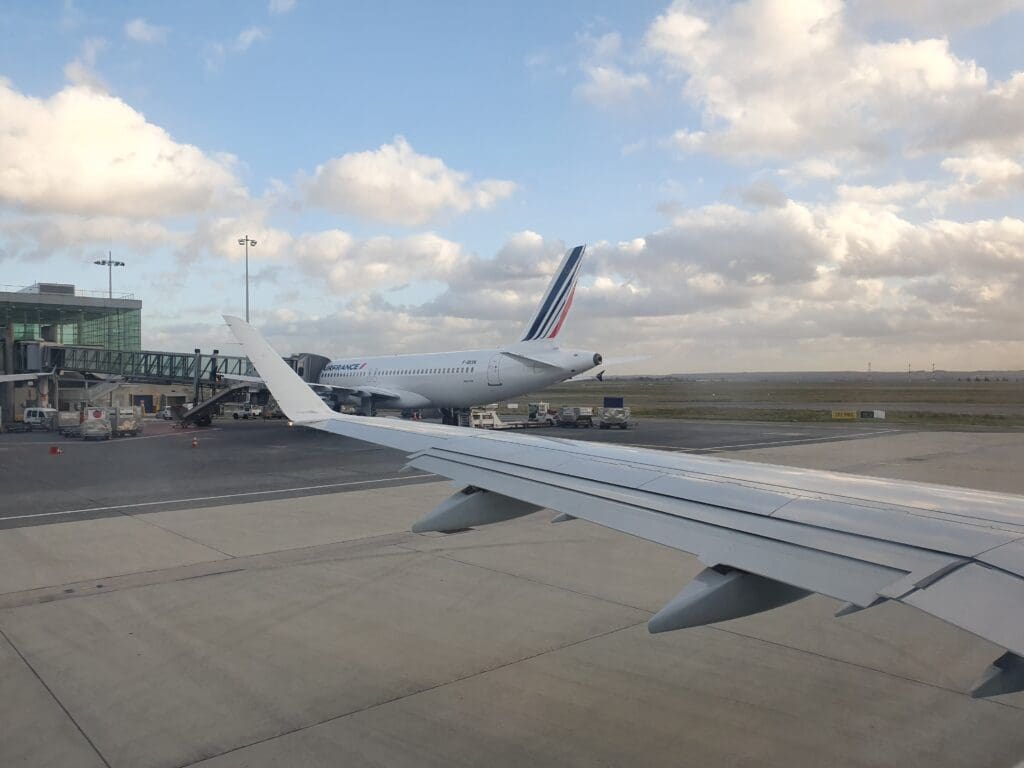
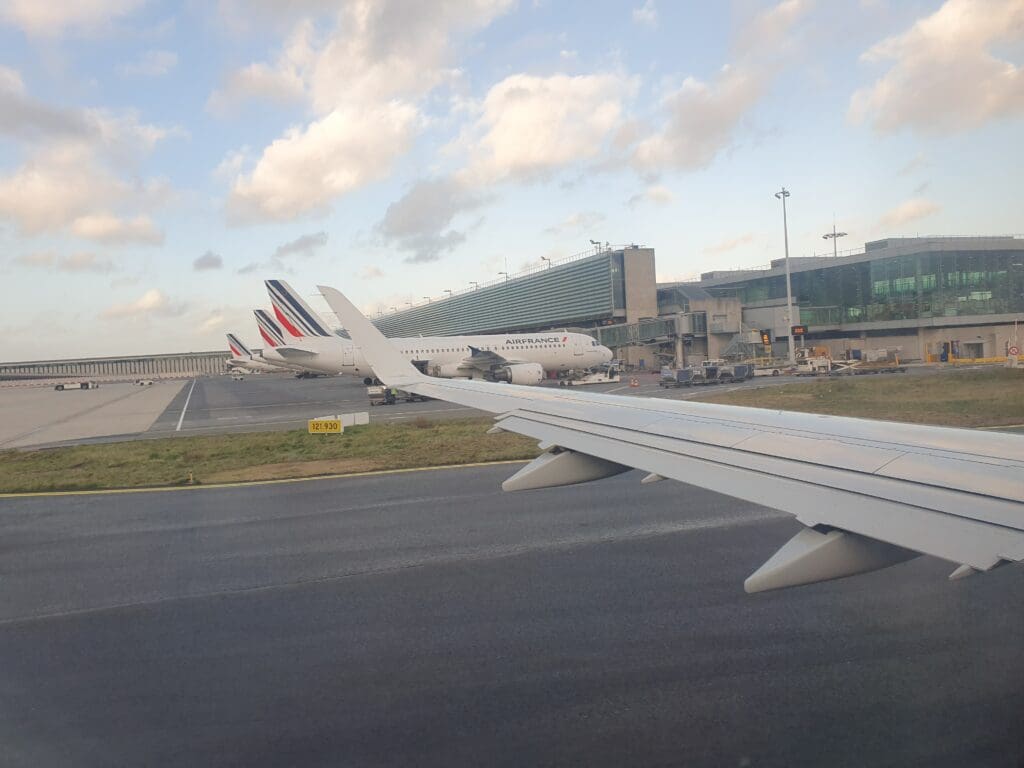
After coming to a halt, one of the ramp workers waved us off and we commenced our taxi away from the satellite terminal, passing a couple of Airbus A320s before heading past some larger Air France jets at Terminal 2E’s M satellite terminal. Interestingly, Air France Airbus A380 F-HPJB could be spotted in an all-white livery, ready for its next life despite still operating services for the airline. After passing Paris CDG’s Embraer farm aka Terminal 2G, our aircraft arrived at the end of Runway 26R. Without any holding, at 1523 ‘Jersey 4 Sierra Tango’ taxied onto the runway and paused. The brakes were held momentarily as our engines spooled up before being released resulting in a rather sudden jolt as our powerful takeoff roll commenced. After a short take-off roll, the aircraft soon rotated, bringing the skyline of St Denis and Paris’ northern suburbs into view however unfortunately haze and low clouds meant that the sights of Central Paris could not be seen clearly.
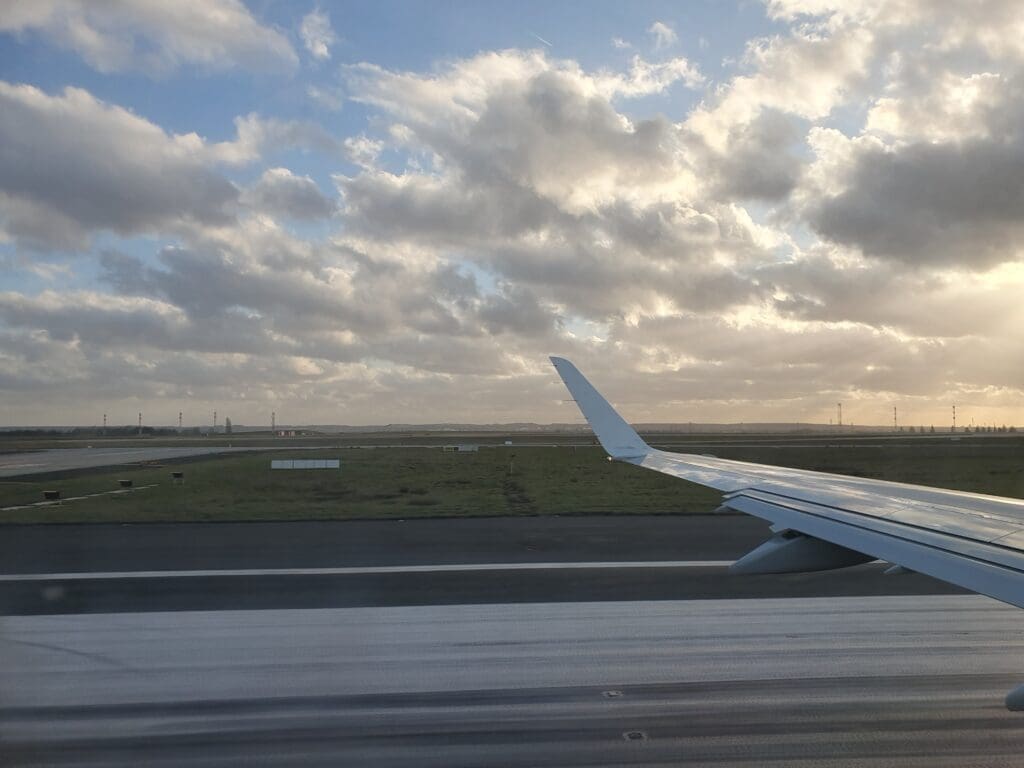
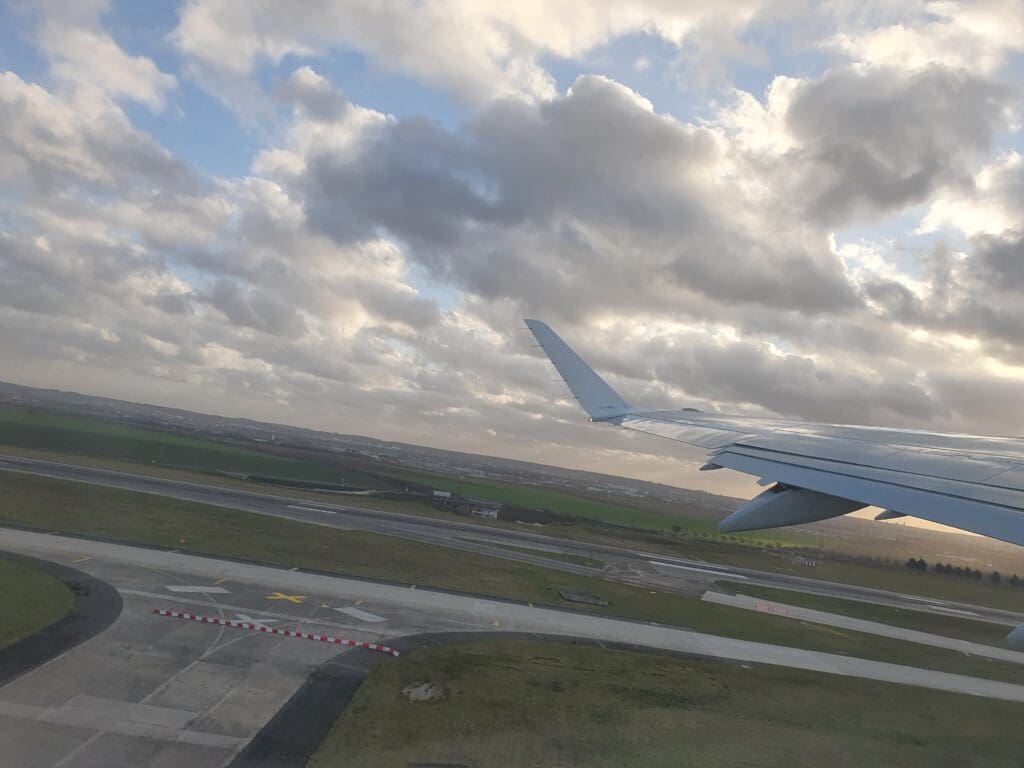
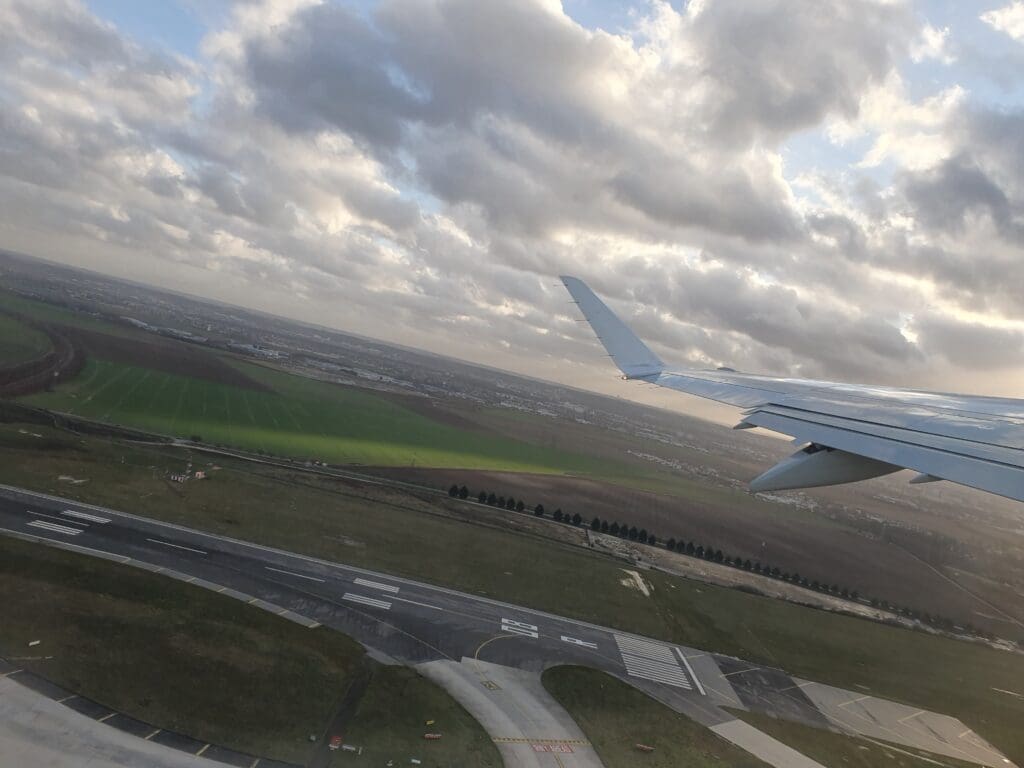
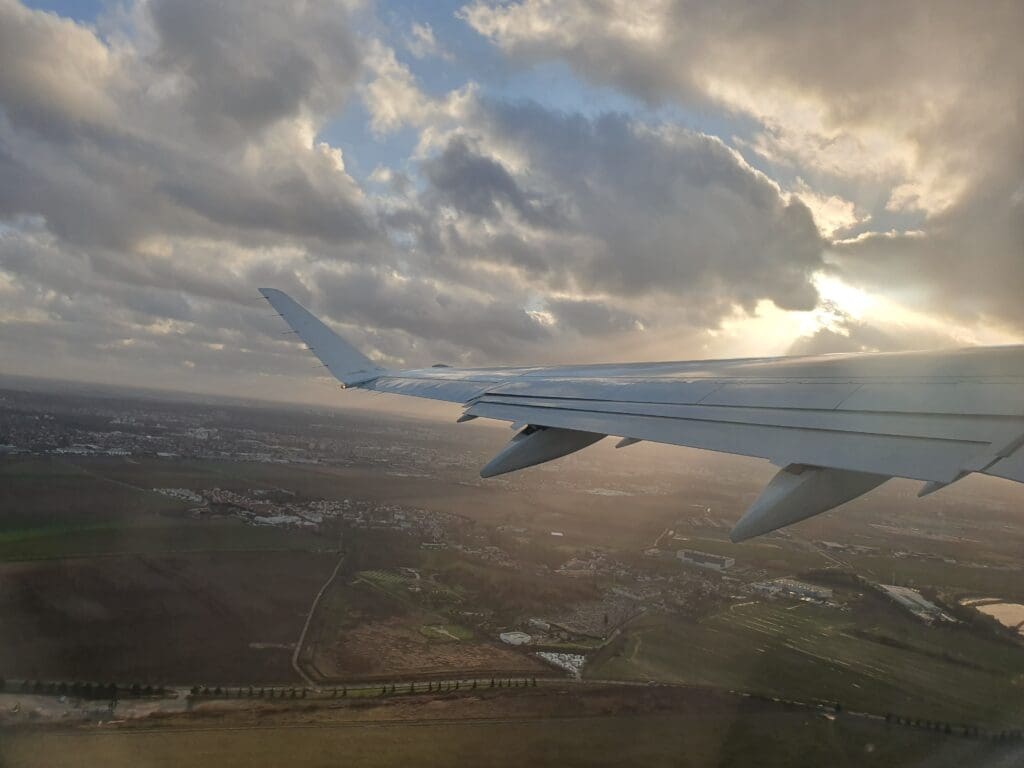
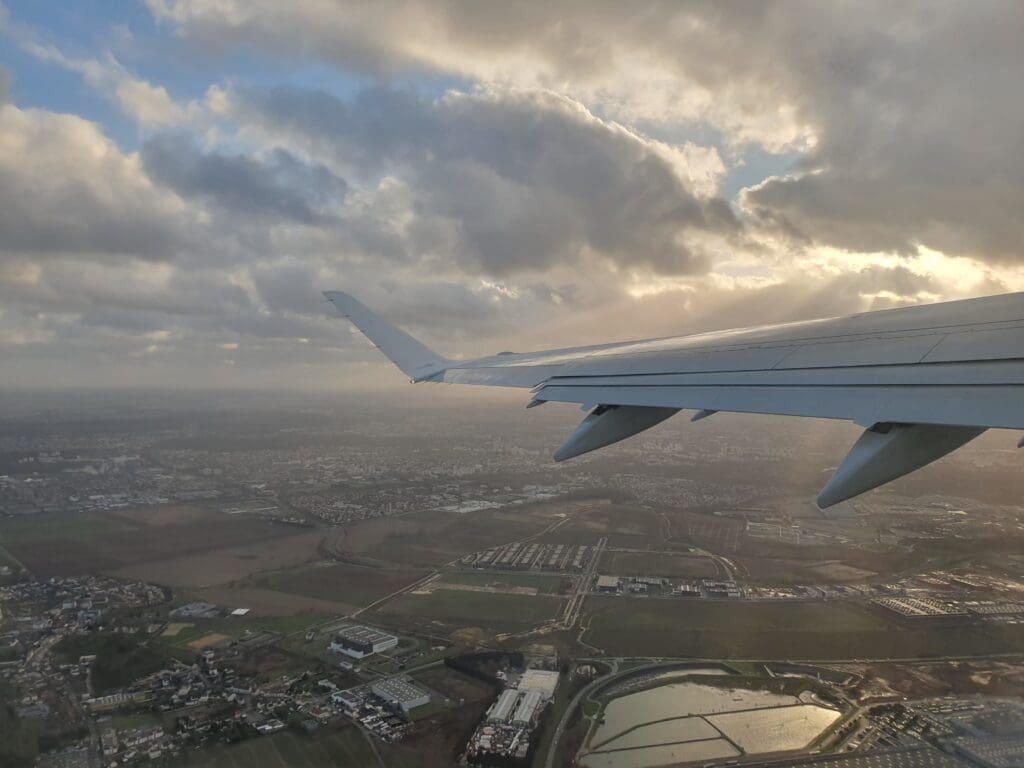
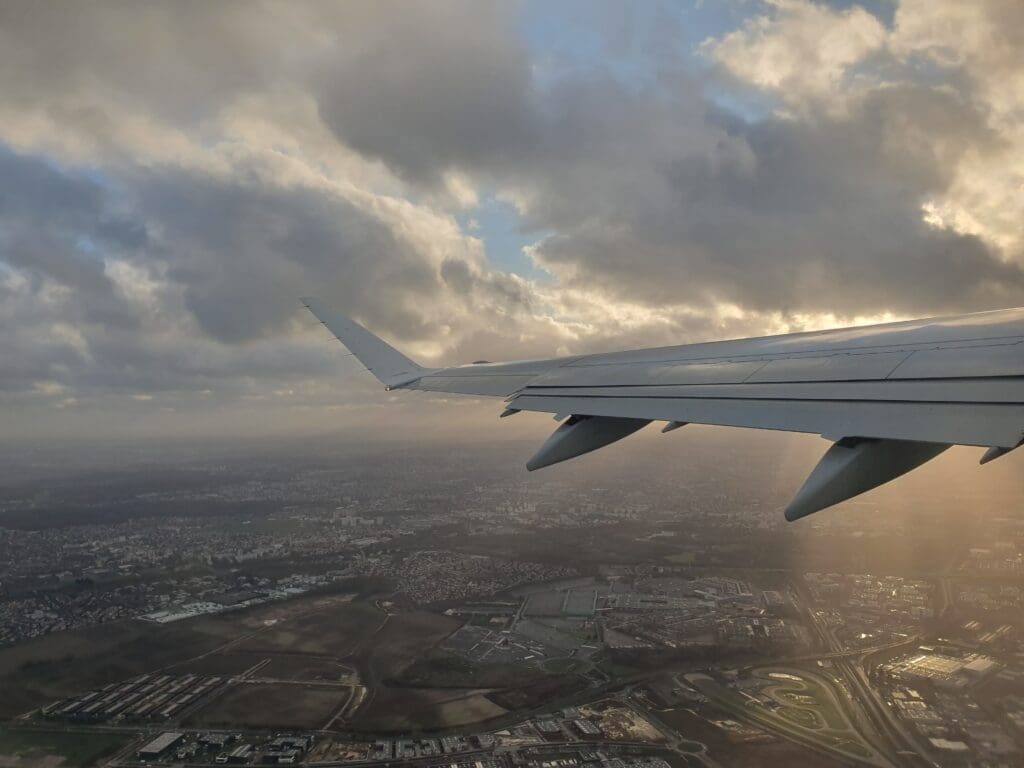
No more than a couple of minutes after takeoff Le Bourget Airport popped into view beneath the aircraft, this being visible for a few seconds before we headed into the clouds and banked right to set us on course for Northern France. As we emerged from the thin layer of clouds, another announcement was made by one of the cabin crew members which detailed the usual seatbelt warning, the locations of the aircraft’s two toilets as well as advertising the inflight BoB service which was set to commence within the next few minutes.
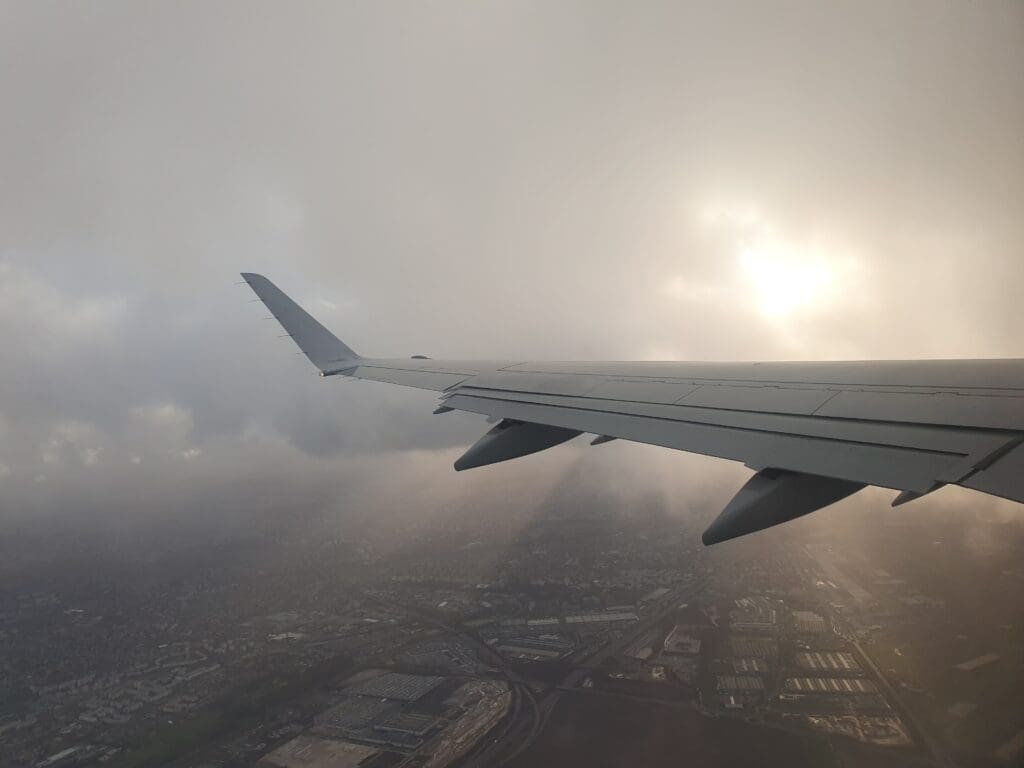
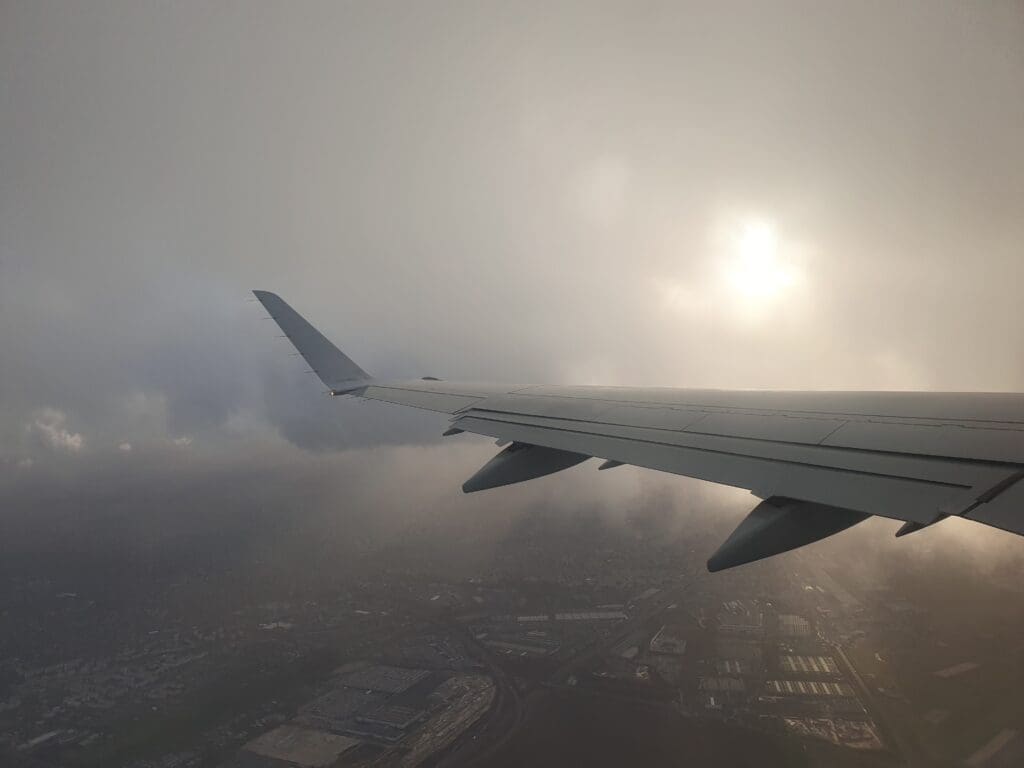
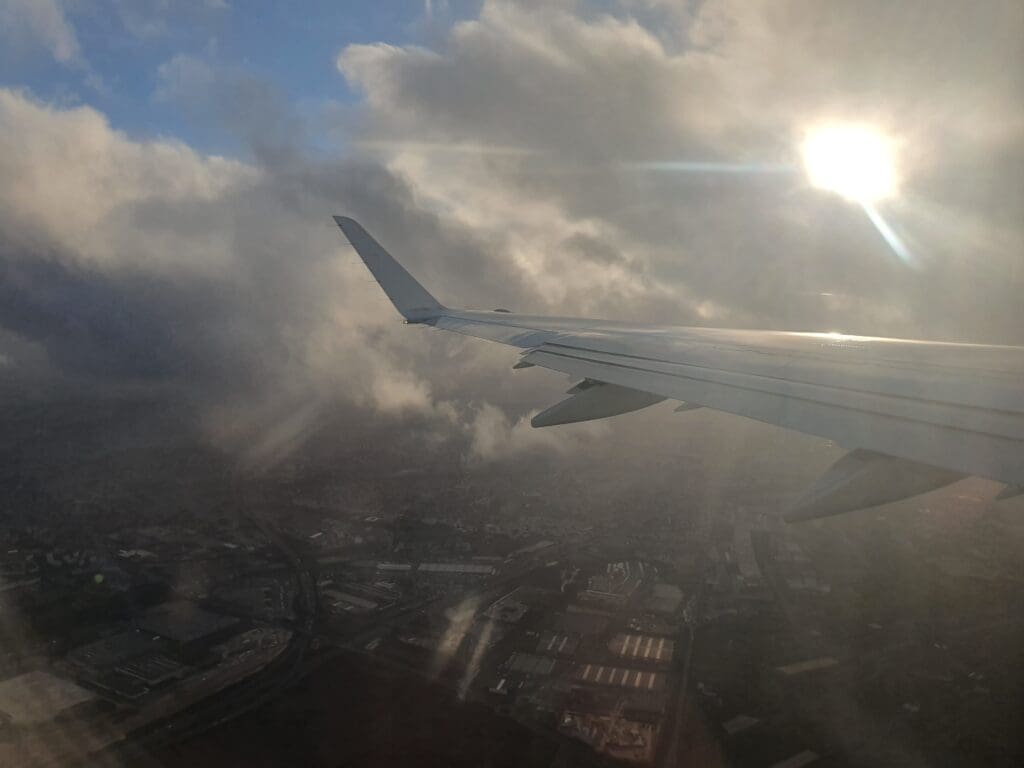
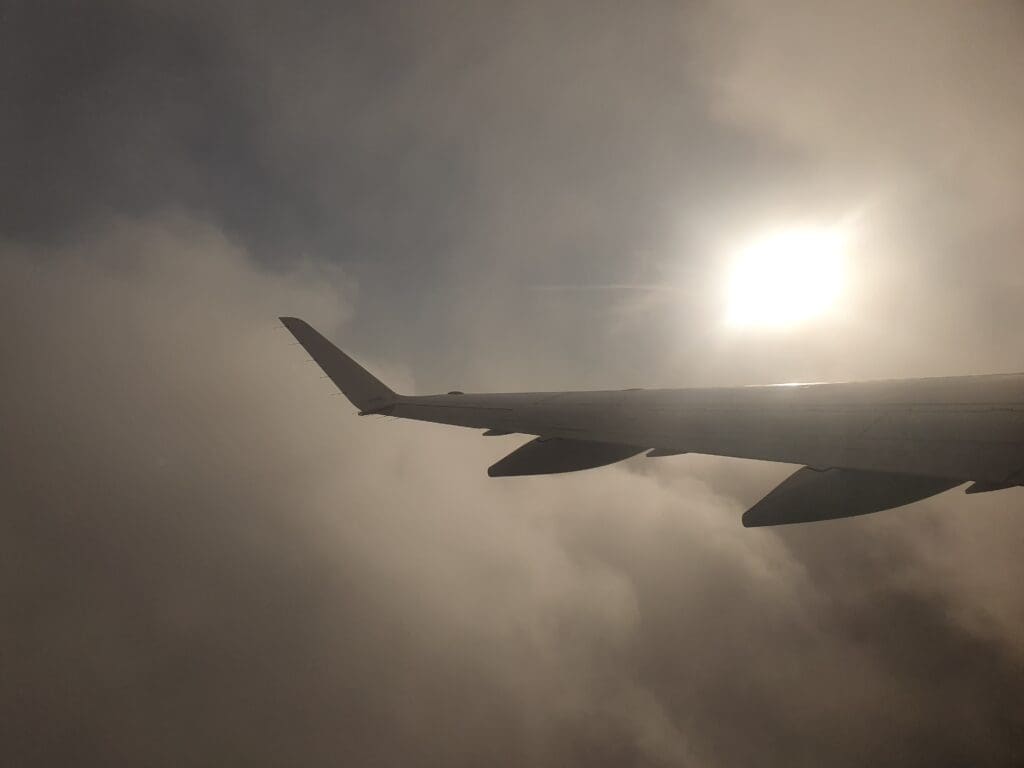
After the seatbelt signs were extinguished, the crew wheeled the trolley from the rear galley up to the front of the aircraft. When it comes to substantial meal offerings, those travelling with Flybe may be a little disappointed. Given the airline’s network consisting of mostly short regional routes and the somewhat ‘small’ nature of the types they operate and subsequent limited galley space, unsurprisingly no hot meals are offered for sale as they are on some of Europe’s other low cost carriers. However, despite this, a comprehensive list of snacks and drinks is displayed in the airline’s Café Flybe menu – these include the usual pastries, sandwiches, soups, sweets and snack boxes in addition to a variety of drinks. Price-wise, these fall in line with other low cost airlines in the region. To give a small sample, those wishing to purchase a sandwich would have to part with £4 or €6, whilst combinations offer slightly better value for money options – for example a pastry and a hot drink the same as a sandwich, or a chocolate bar and hot drink for £3.50 / €5.25. Seeing as I had sampled the delights of Flybe’s instant ‘cappuccino’ on my flight from Birmingham in the summer, I decided to pass on any of the BoB options.
Unfortunately, for the majority of the flight, the omnipresent cloud cover below prevented any views of the ground below. However, after levelling off at 26,000 feet around twenty minutes after our departure, France’s northern coastline came into view near Dieppe through a very temporary gap in the clouds. With little to see outside for much of the flight, I decided to turn my attention to the December 2019 edition of the airline’s Flight Time magazine located in the seat pocket. This magazine is split up into five sections – take off (detailing events and some semi-advert style features on hotels and restaurants), people (containing a couple of interviews with a Flybe mechanic and actor Jeremy Irons), travel (with articles on Durham, Inverness, Morzine and Paris), business and last but not least, Inside Flybe, which detailed news and information related to the airline. Overall, this was a fairly standard inflight magazine, with nothing making this stand out from that offered by any other airline. As we cruised north, the bright sinking sun lit up the cabin, providing a scenic view out of the small porthole. However, aside from illuminating the cabin, this also highlighted the window’s vast array of smudges and scratches, which ultimately made taking of any decent-quality photos nye on impossible. Inside the cabin, by the time the two crew members reached the rear of the cabin, our aircraft had already crossed the British coastline near Hastings. Given the flight’s short duration, one crew member proceeded to the front of the aircraft to commence the first rubbish collection round.
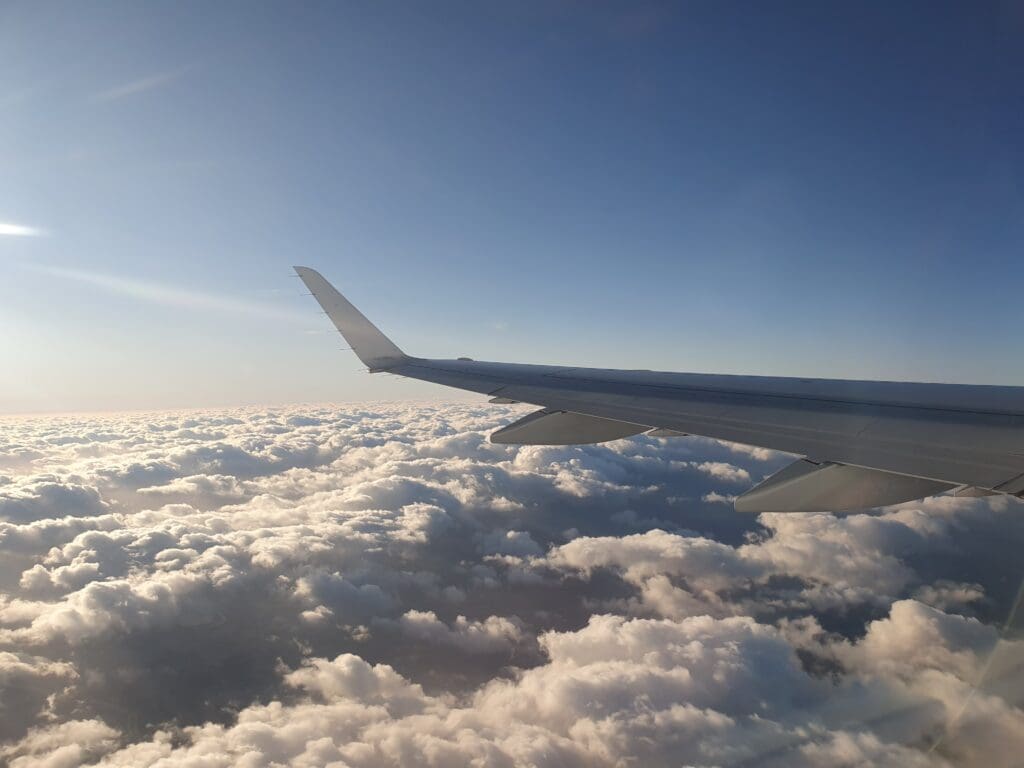
Turning my attention back outside, the clouds opened up temporarily once more, allowing for hazy views of the countryside near Tunbridge Wells as we headed towards London. Whilst over the capital city, at 1505 UK time, the aircraft could be felt commencing its descent back towards the ground. This was followed almost immediately by a ‘cabin crew prepare the cabin for landing’ announcement from the cockpit and a longer announcement from one of the two cabin crew members. This contained all of the usual information regarding window shades, tray tables and seatbelts, in addition, passengers were asked to refresh their knowledge of safety procedures by having another look at the safety card and were reminded to leave all items of hand luggage onboard in the event of an emergency. Having had the ink from a Biro leak onto my hand, I decided to head to the bathroom once again to wash this off, upon entering the small toilet at the rear of the aircraft, I was somewhat disheartened to see a puddle of liquid gathering in one corner of the toilet.
After my quick handwash trip, I returned to my seat and strapped myself in as we bumped down towards the Midlands. Soon enough the seatbelt sign was turned on and the crew passed through the cabin making a final rubbish round and ensuring the cabin was secured for landing. Outside, the English countryside came into view just to the north of the Oxfordshire town of Banbury. Heading northwards over Warwickshire, I spotted what first looked like an airfield before soon realizing this to be some form of disused facility now having something to do with cars. As it turned out, this was former RAF Gaydon, an airfield that had once been home to amongst other types, English Electric Canberras, Handley Page Victors, Vickers Valiants and Varsities. As we headed towards Birmingham, once we had passed Warwick there was relatively little to see outside bar plenty of green fields and the occasional town. As we neared the airport, the flaps were lowered which was eventually followed by the dropping down of the aircraft’s landing gear. Inside the cabin, several small ice droplets fell onto my lap as we sank downwards!
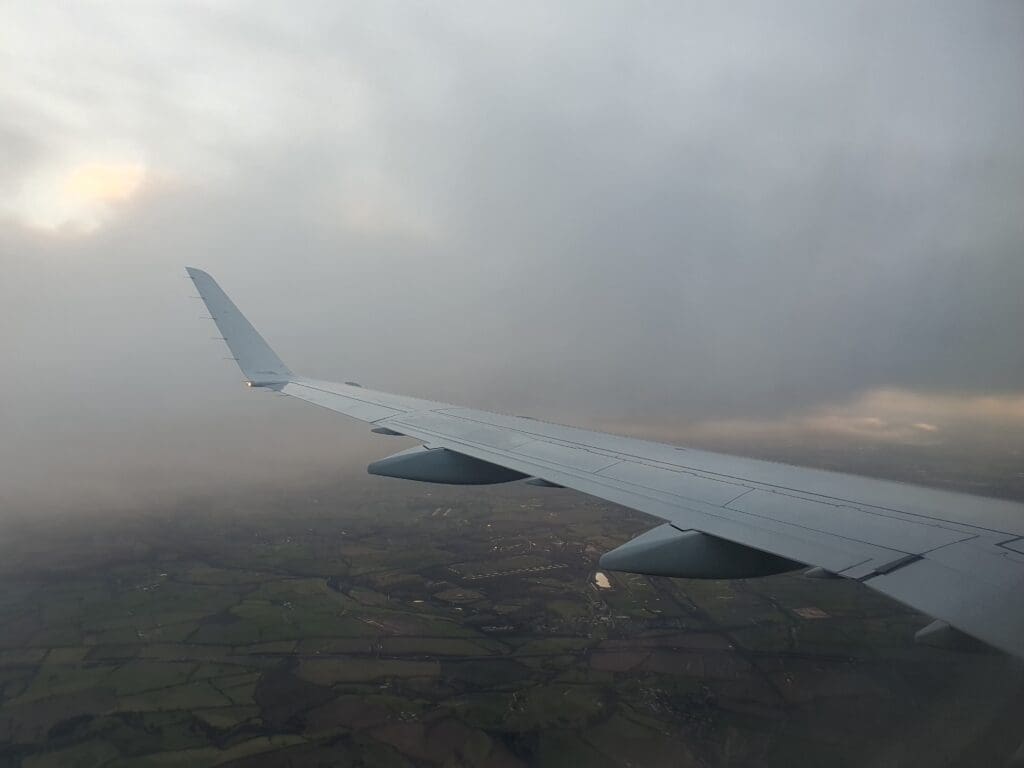
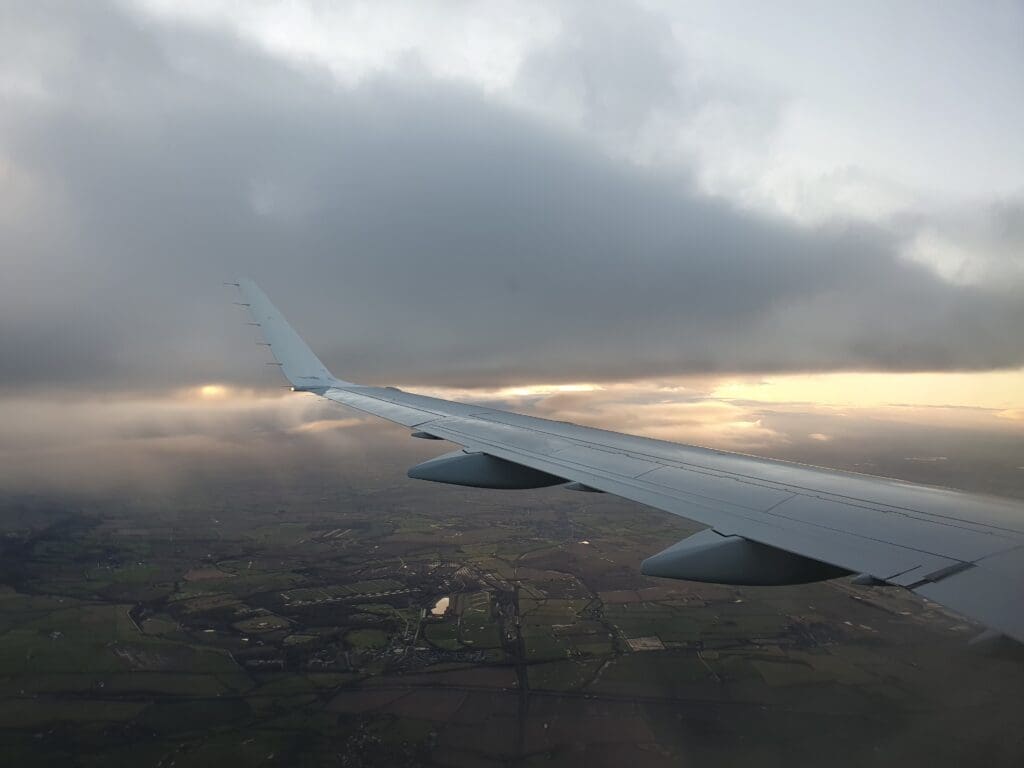
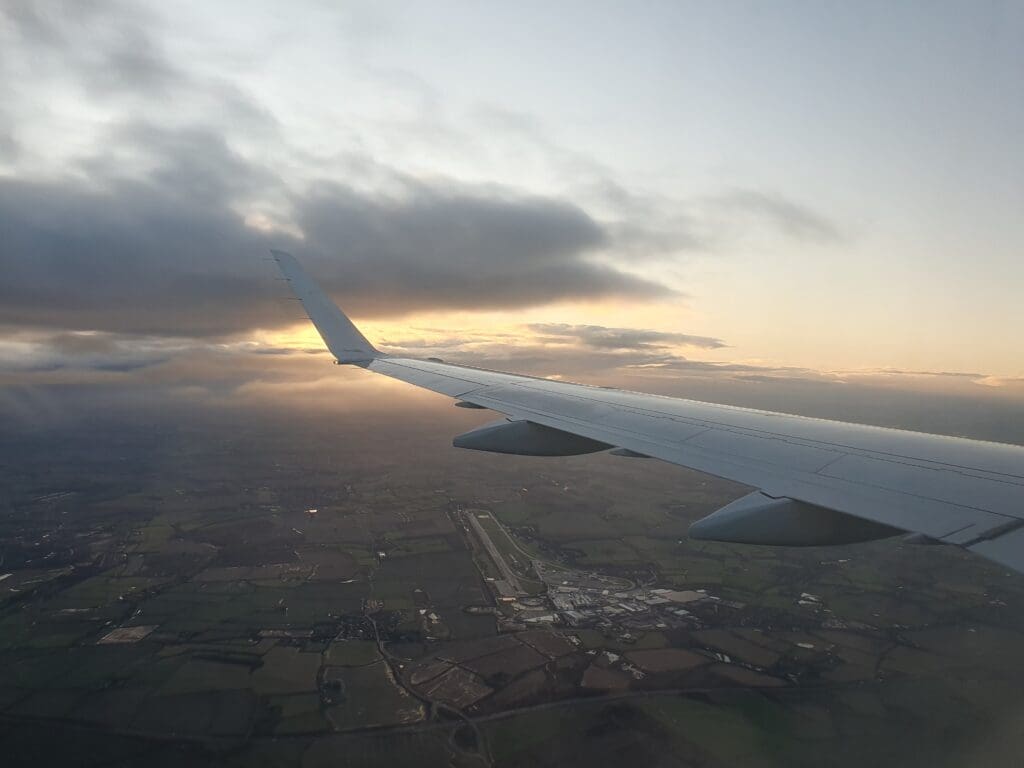
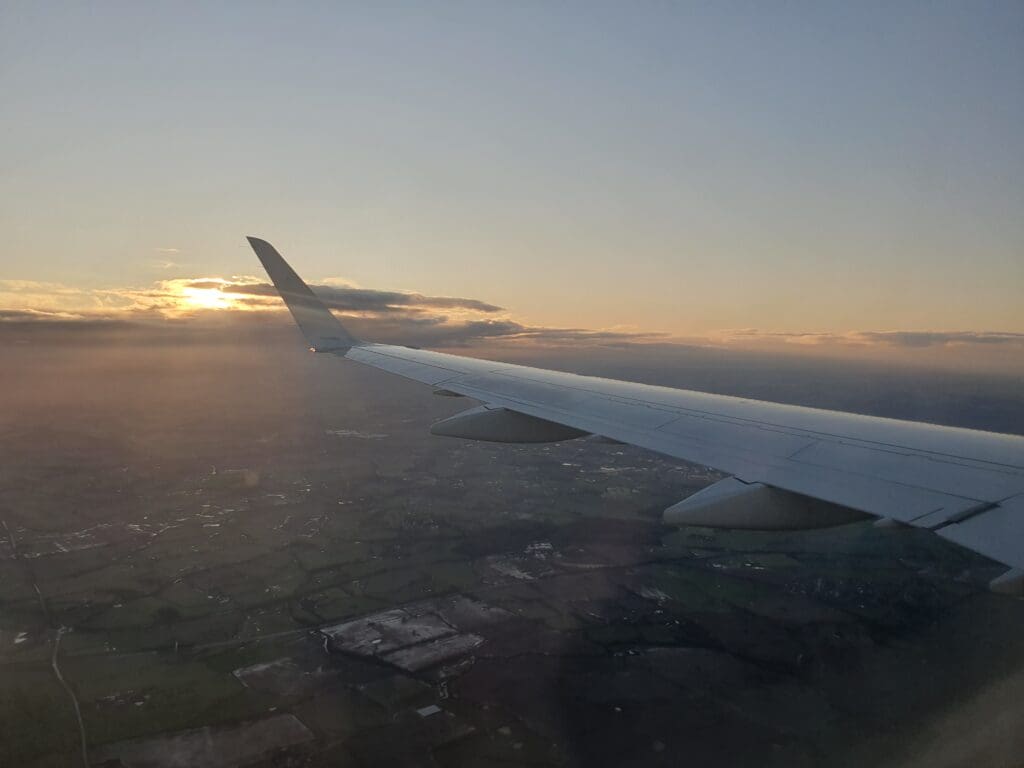
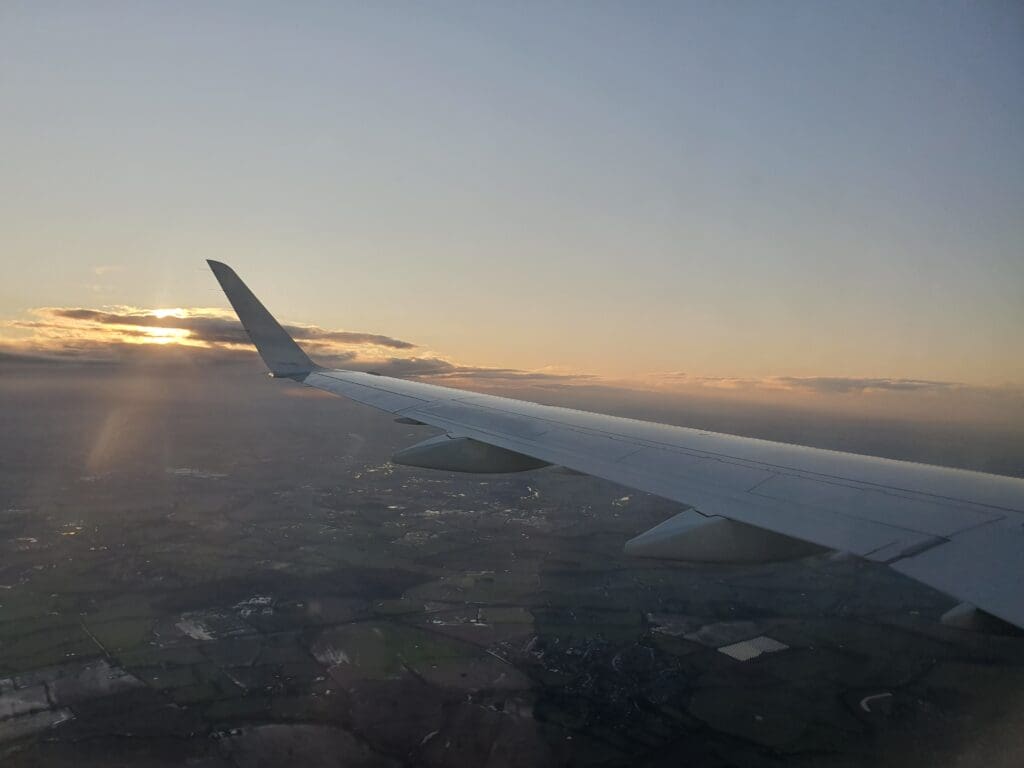
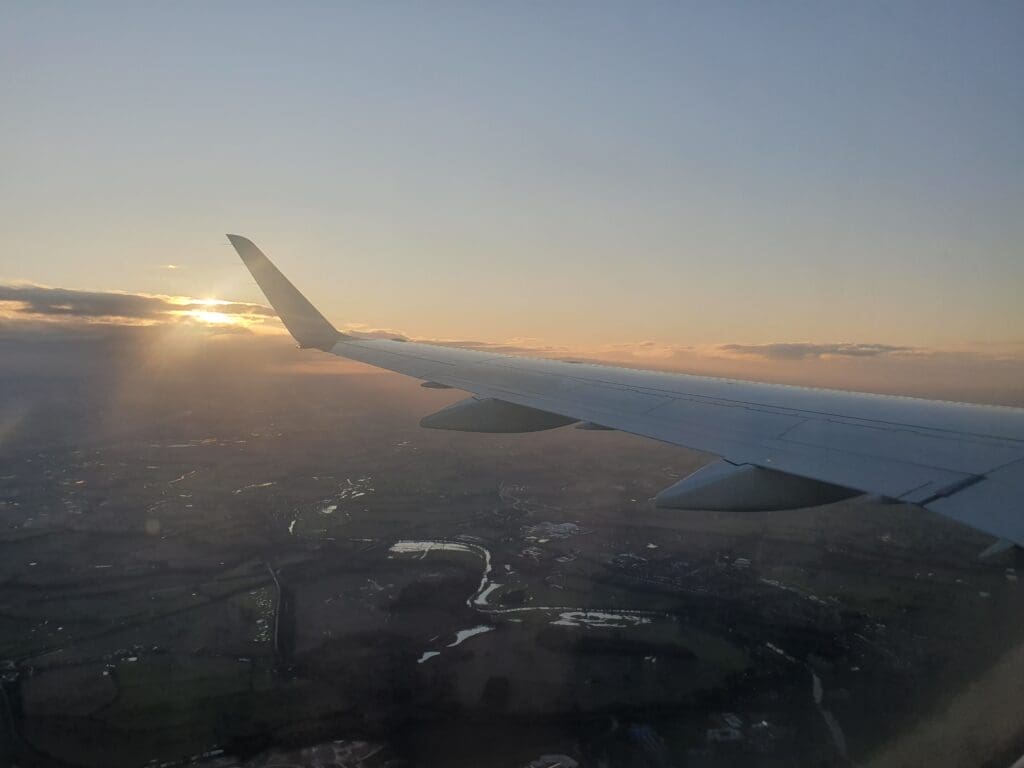
Heading from the southeast and with Runway 33 in use, no major changes in course were necessary during the approach and before I knew it we were passing over the M42 indicating our imminent arrival whilst the skyline of Central Birmingham popped up on the horizon. At 1526, an hour and two minutes after taking off from Paris, the aircraft gently touched down before the spoilers flew up and reverse thrust activated as we gently slowed. Sitting on the left hand side of the aircraft, unlike those on the right, I was not given a view of the airport’s main terminal but instead of the old Elmdon Terminal and former Monarch hangars – here, only two aircraft could be seen parked, Boeing 737-300F and a BAE ATP-F, both 31-years old and operated by West Atlantic.
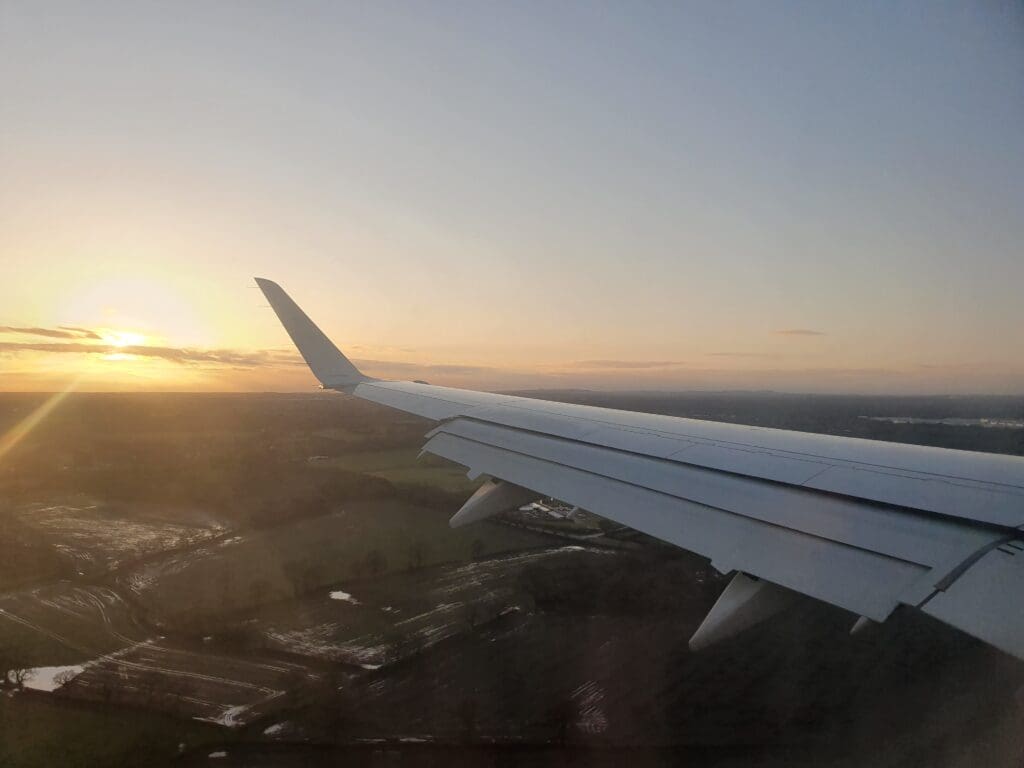
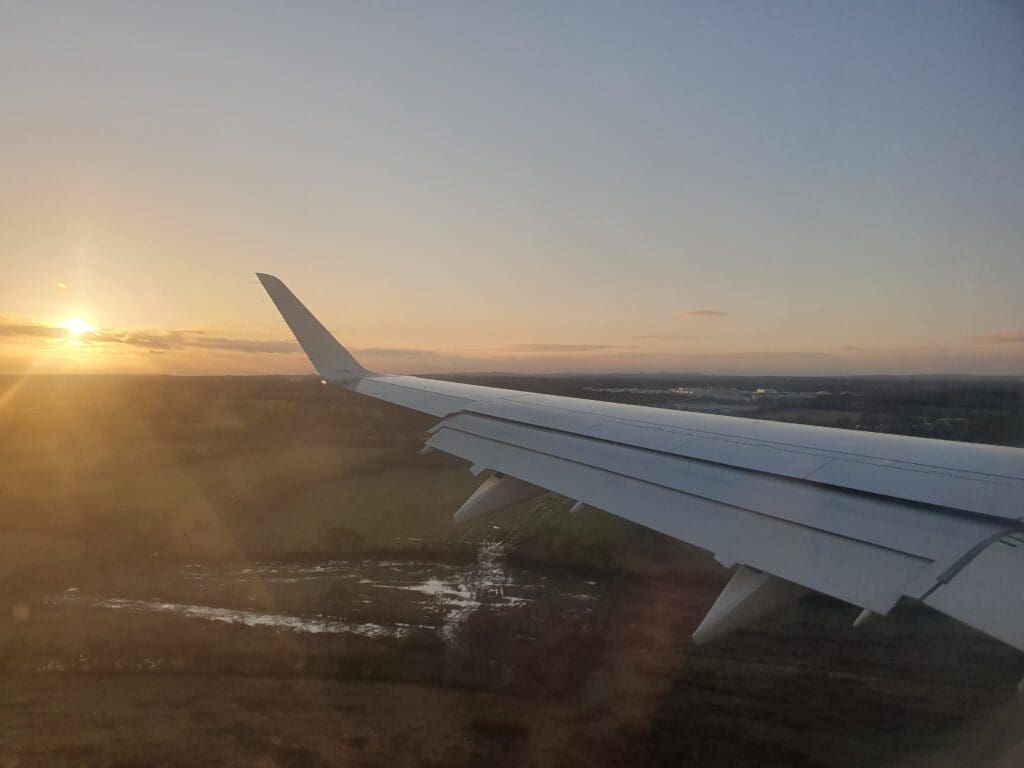
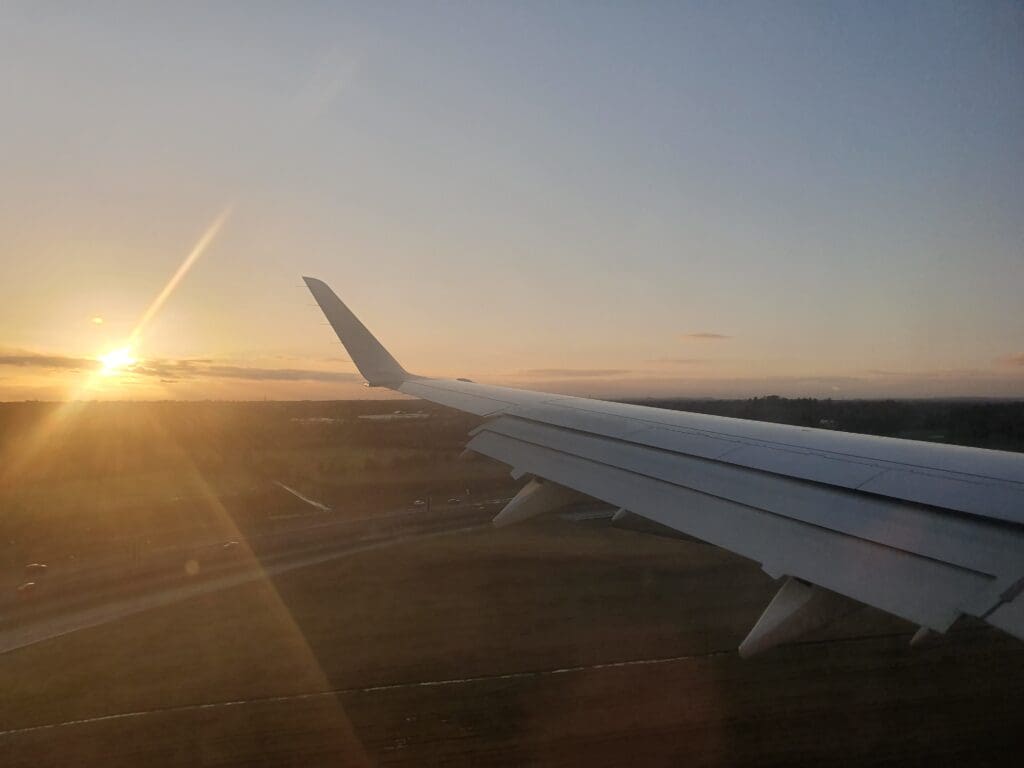
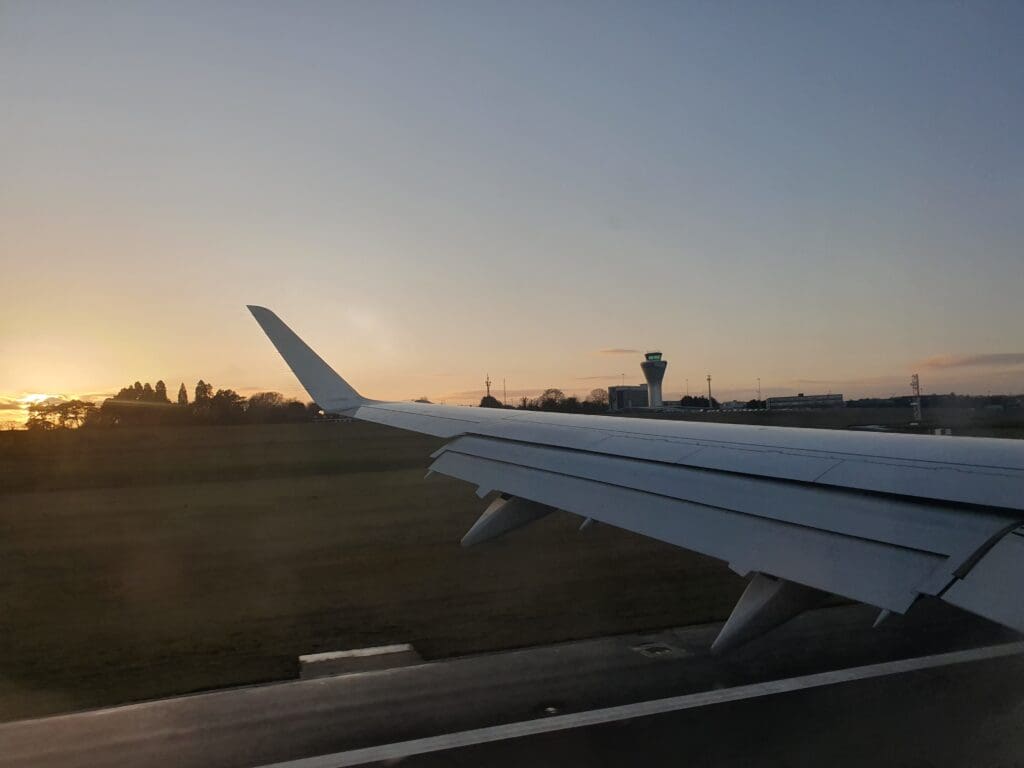
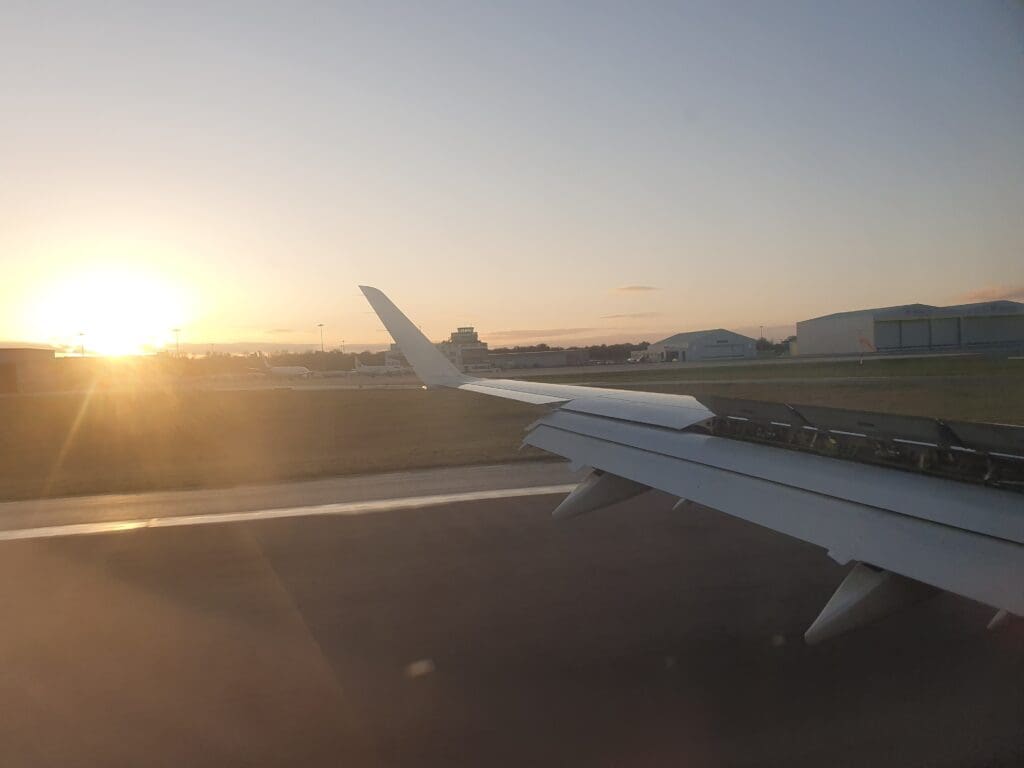
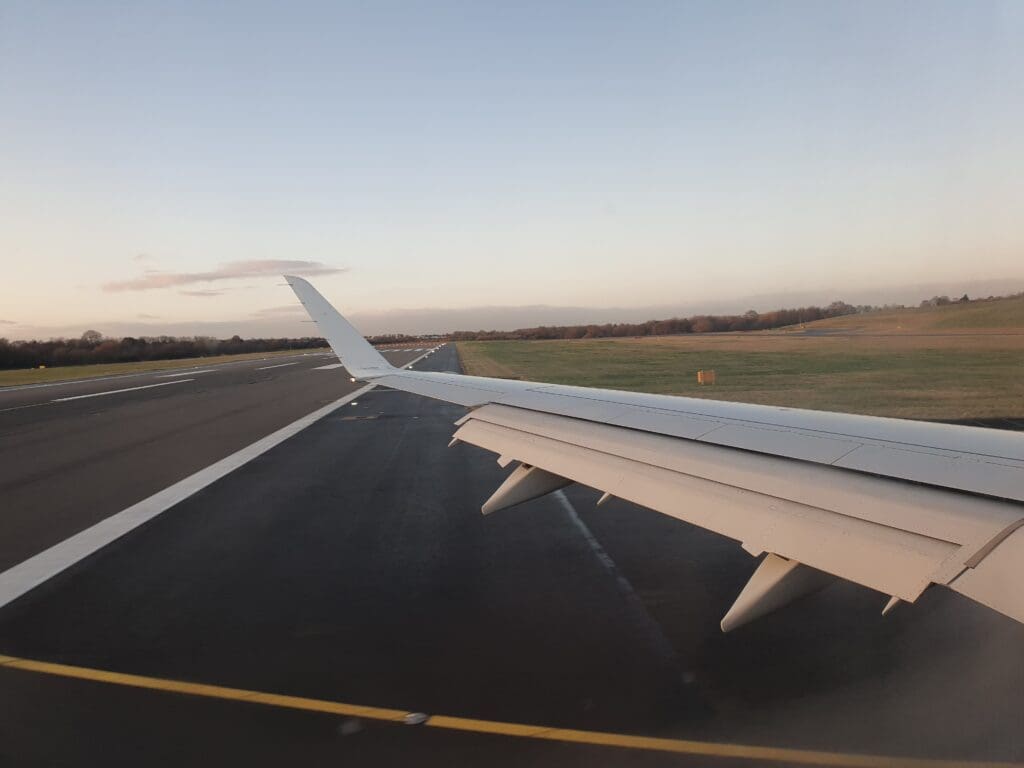
After a slow deceleration, our aircraft taxied off the runway and one of the cabin crew members performed an announcement welcoming all passengers to Birmingham and thanking us all for flying with Flybe. During our short taxi to the older portion of the terminal, utilised only by Flybe and Ryanair (as far as I am aware), we passed a line of six Jet2 Boeing 737s and a Turkish Airlines Boeing 737 preparing for its flight back to Istanbul as well as a Qatar Airways Boeing 787-8, soon to be joined by an Air India Dreamliner from Amritsar and a PIA Boeing 777-200ER from Islamabad which were both on approach at the time. Six minutes after touching down, our Embraer pulled into stand 5 before coming to a halt. Once the engines were shut down, the cabin jumped up, however, it was another few minutes before stairs were brought up to the aircraft and disembarkation commenced. Seeing as I was at the rear of the aircraft, I was one of the last to disembark and at 1540, I thanked one of the cabin crew members and the Captain and wished them a Merry Christmas before I headed down the steps.
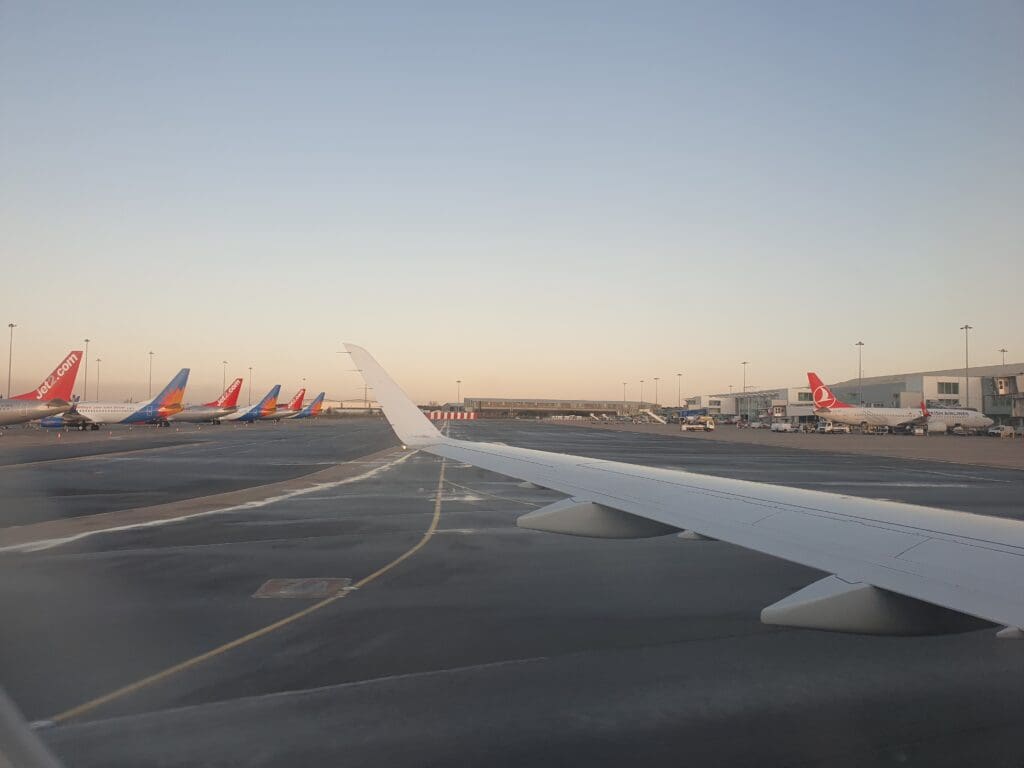
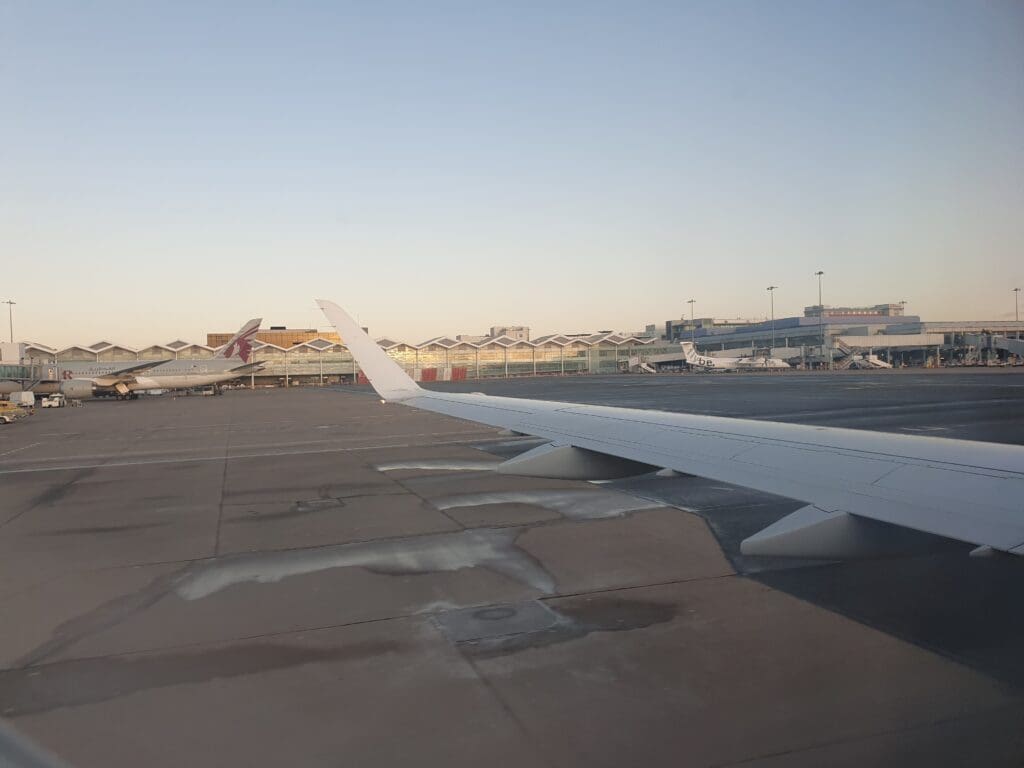
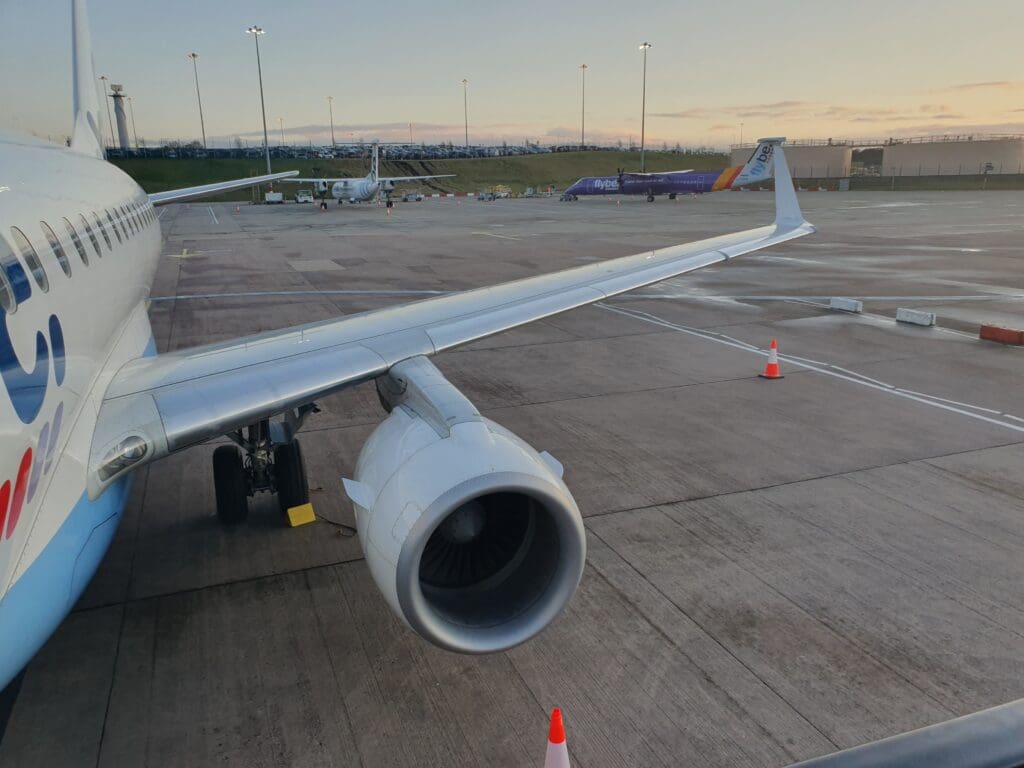
Given the short distance to the terminal, I was somewhat surprised to see that a bus had been put on to transport us around 40 metres to the doors for international arrivals. Nevertheless, seeing as I was one of the last to board the bus, only seconds after I hopped aboard, the doors were closed and we slowly edged towards the terminal. Once here, the doors opened and we all headed inside and up the stairs leading to the immigration hall. This was my first time arriving at the older portion of Birmingham’s terminal (the last time was in 2007 when I had arrived on a Flybe Embraer 145 inherited from BA Connect) and my first time arriving on an international flight. Overall, this portion of the terminal has a very 1990s feel to it as if it has only undergone minimal renovation since this decade. This also extends to the immigration hall, holding the false belief that no international terminal arrivals hall lacked automated immigration gates, I was surprised to see that these were absent from this dated-looking hall and instead replaced by four immigration desks. That afternoon only three of these were manned – two for those usually able to use the automated gates – EU citizens as well as those from a selection of other countries (Canada, Japan, Korea, Singapore etc) and one desk for those from all other nations. Thankfully, given the fairly quick processing of each passenger at the former two desks and being near the front of the immigration queue, I officially reentered the UK at about 1545 – the scheduled arrival time of the flight! Whilst this older section of the terminal may be a hark back to the past, on the plus side, it is rather small with the baggage collection hall immediately after the immigration desks. Seeing as I had no luggage, I headed straight out and soon found myself greeting my father once again in the landside arrivals area.
Summary
Starting with the positives, Flybe was able to get me from Paris to Birmingham on time (technically ahead of schedule) and more importantly, in one piece. Whilst my interaction with the crew was somewhat limited, they went about their duties and interacted with passengers in a very friendly manner. Furthermore, the seat was pleasant enough for this short flight. However, in line with the other Embraer-operated flights I had taken with the airline, the cabin was in a disappointingly poor state.

